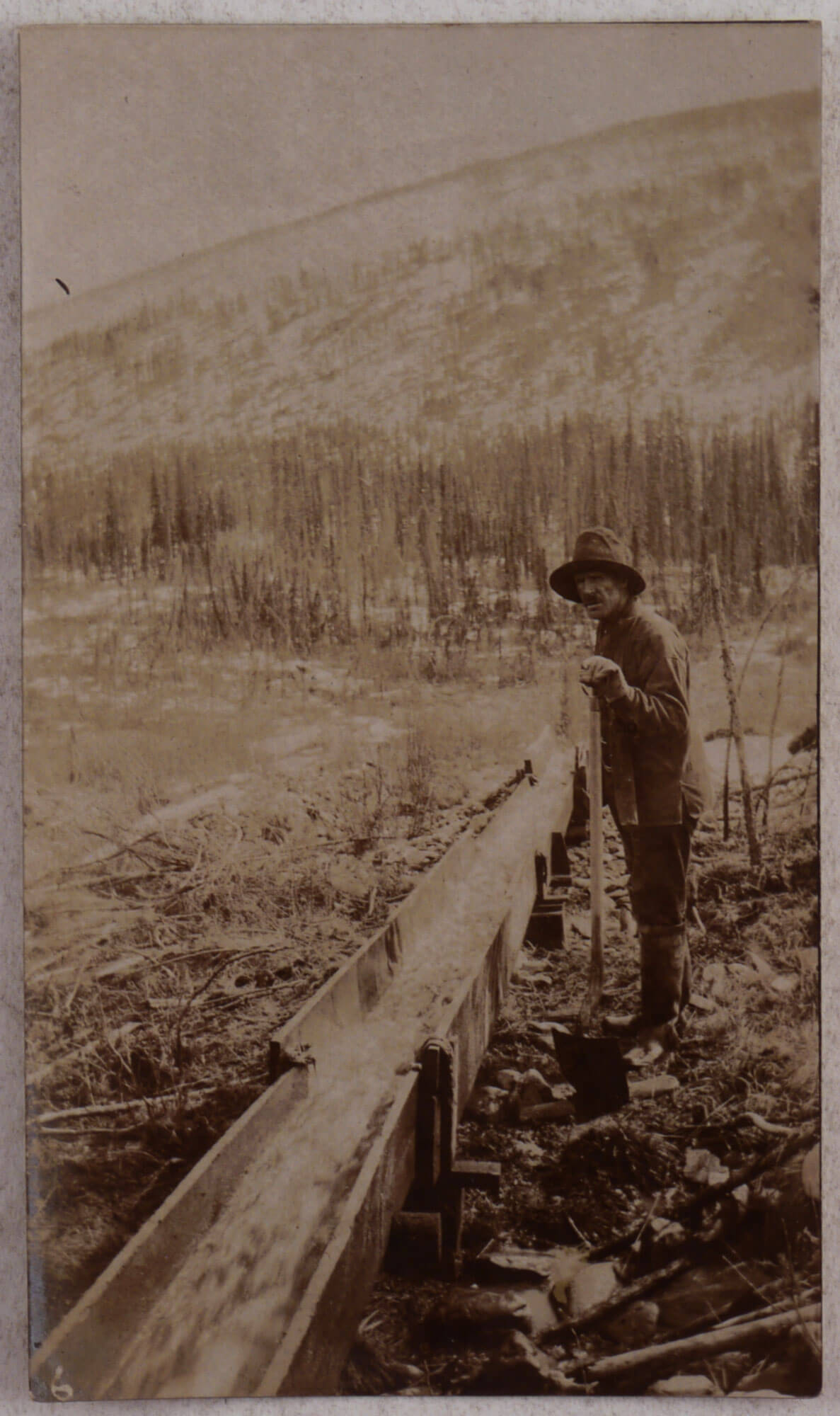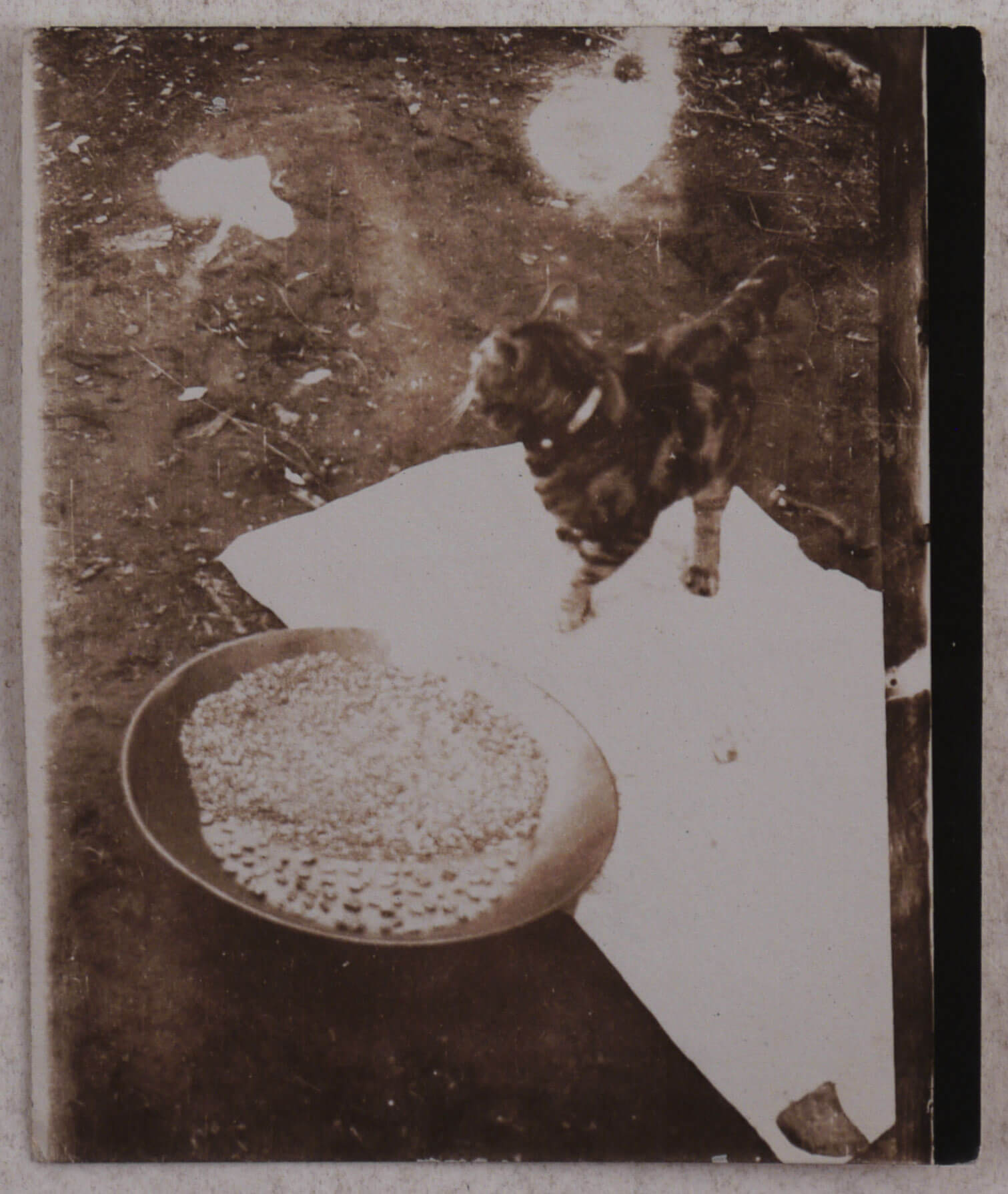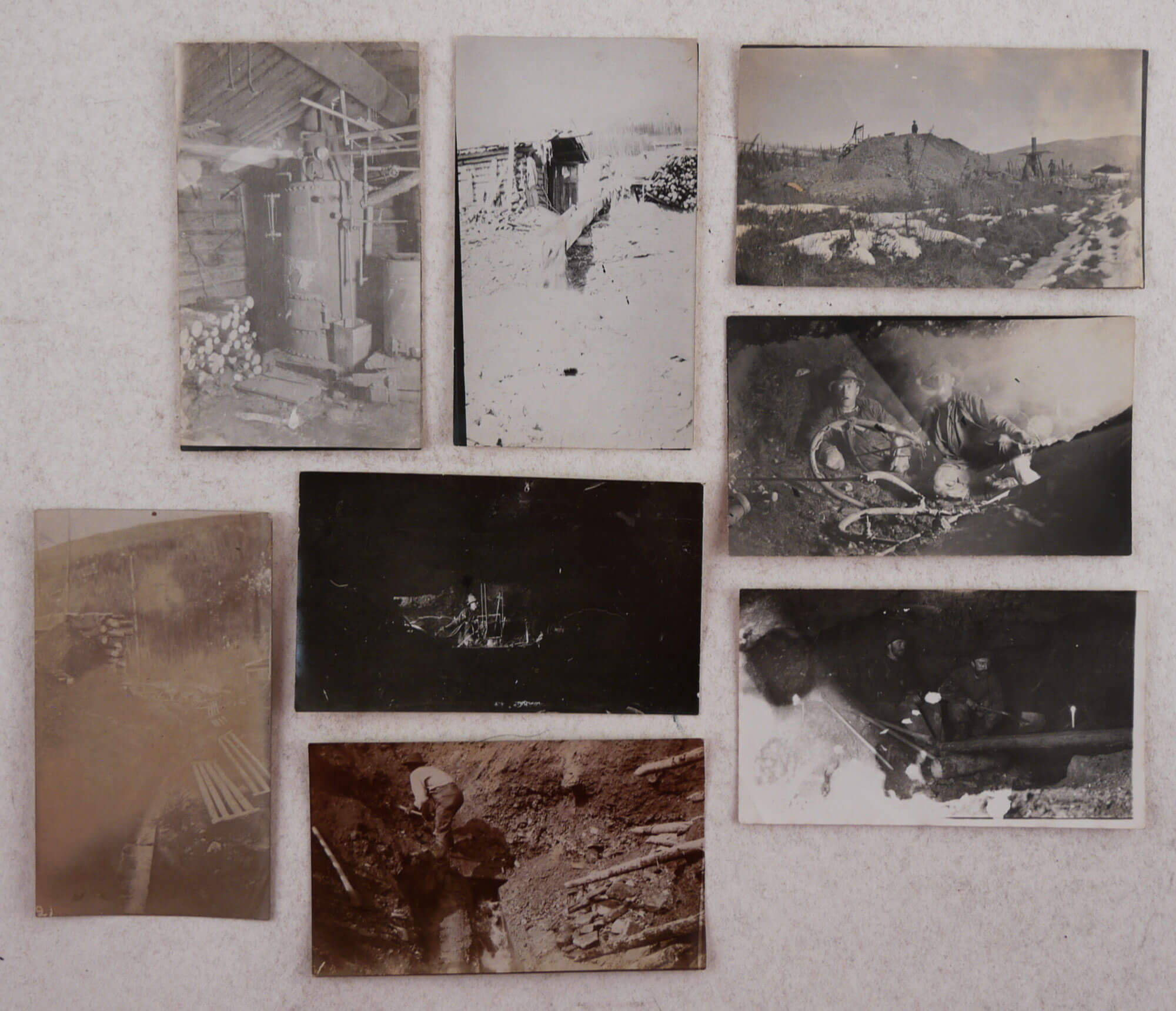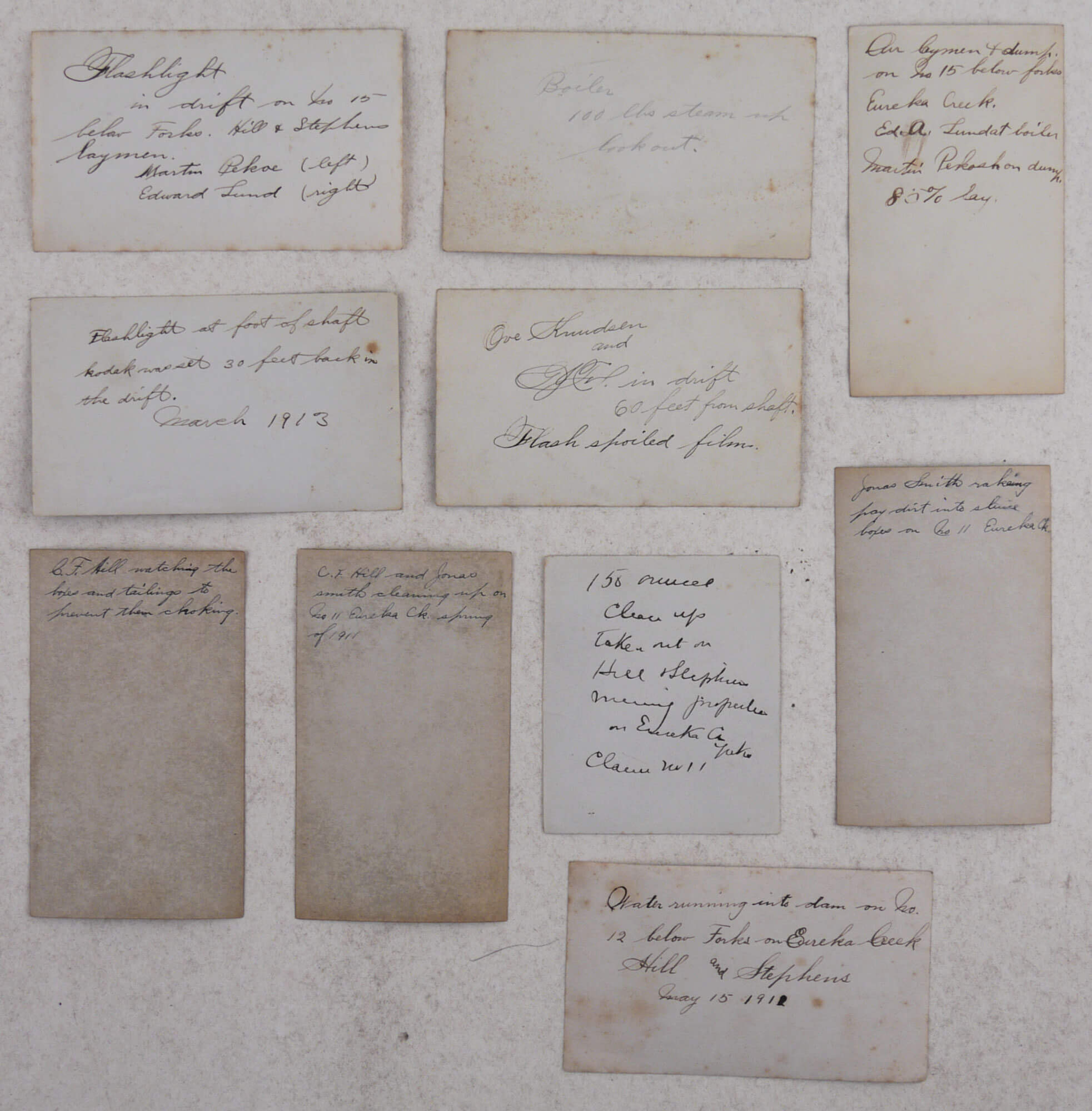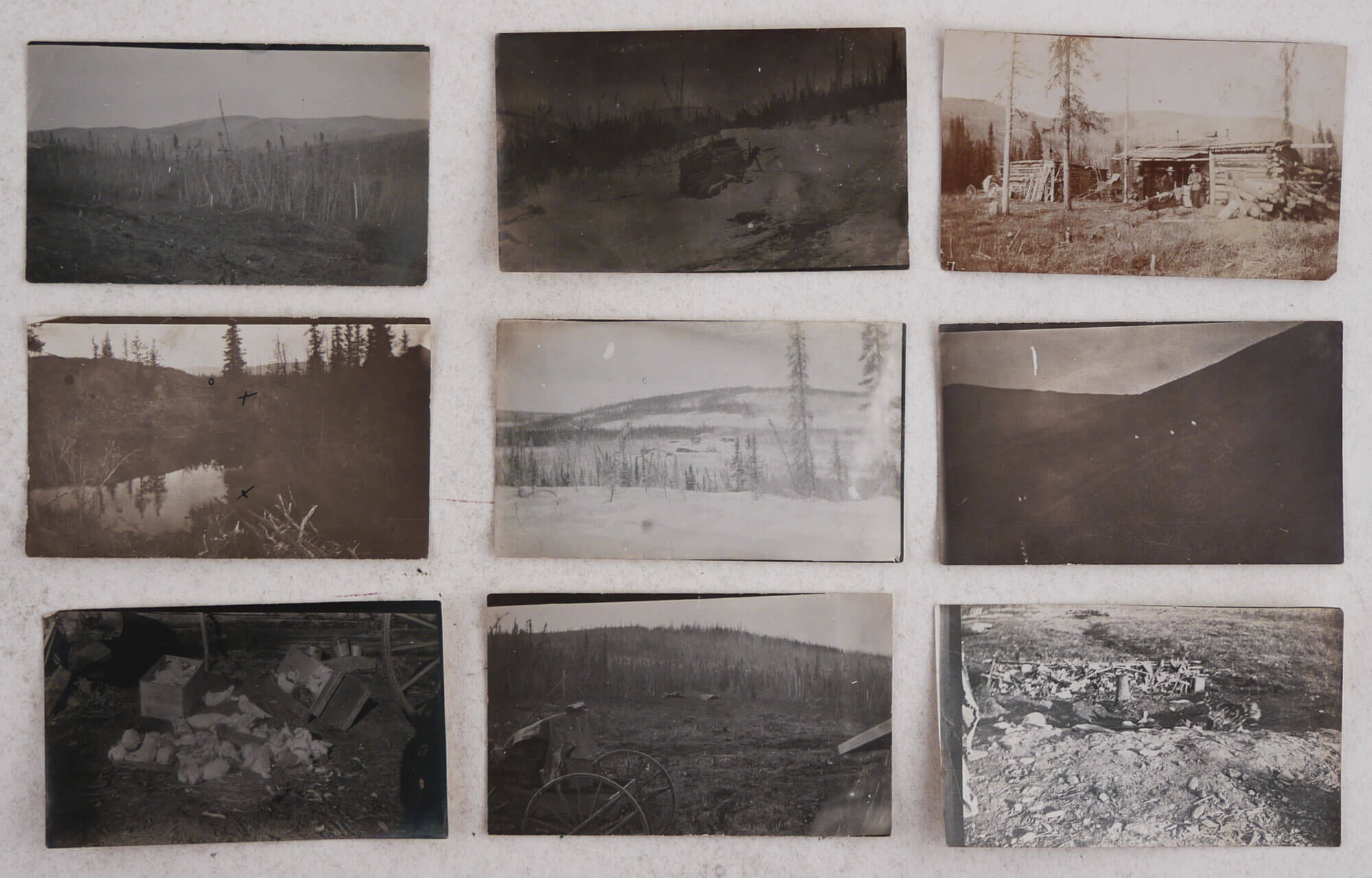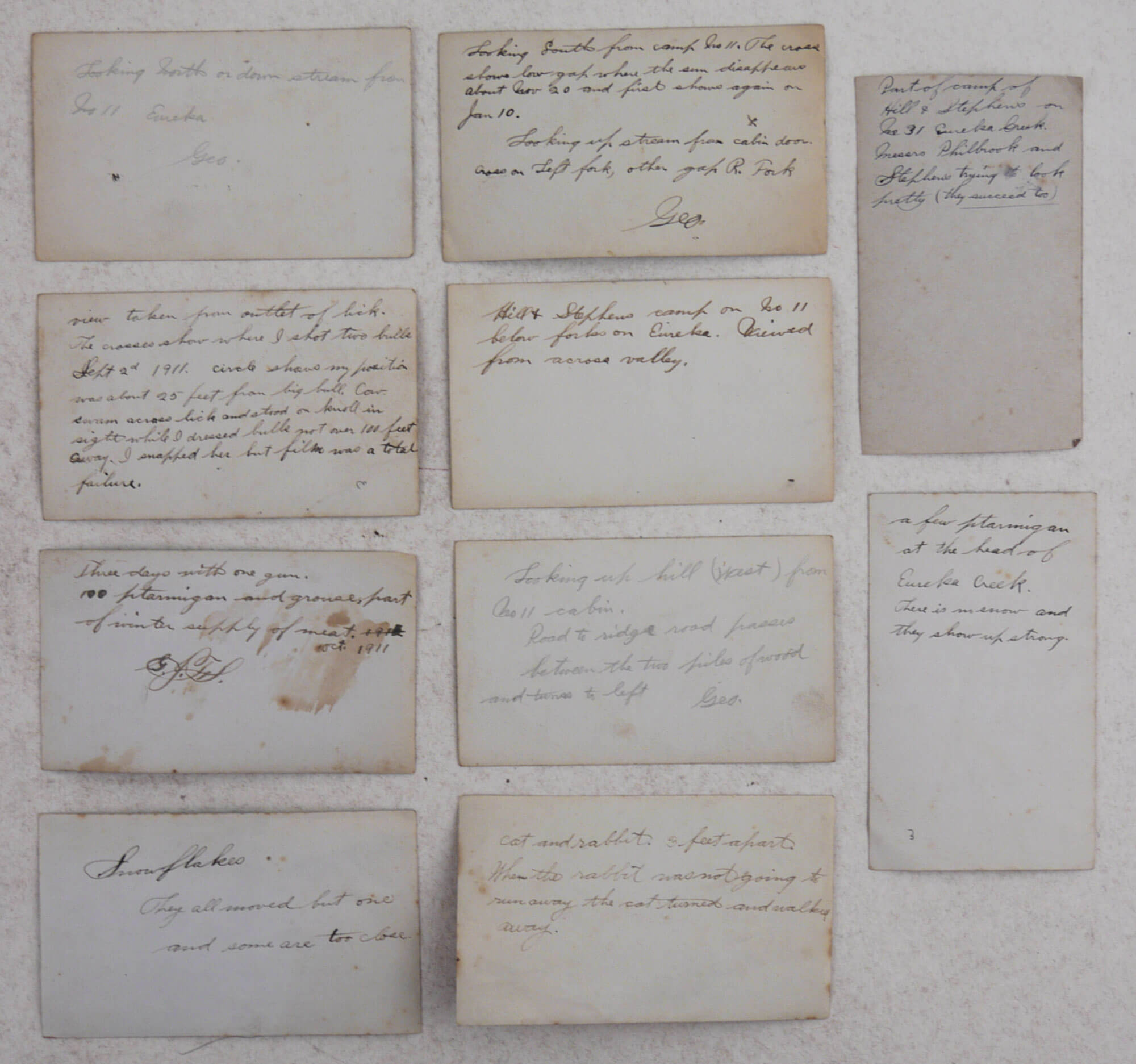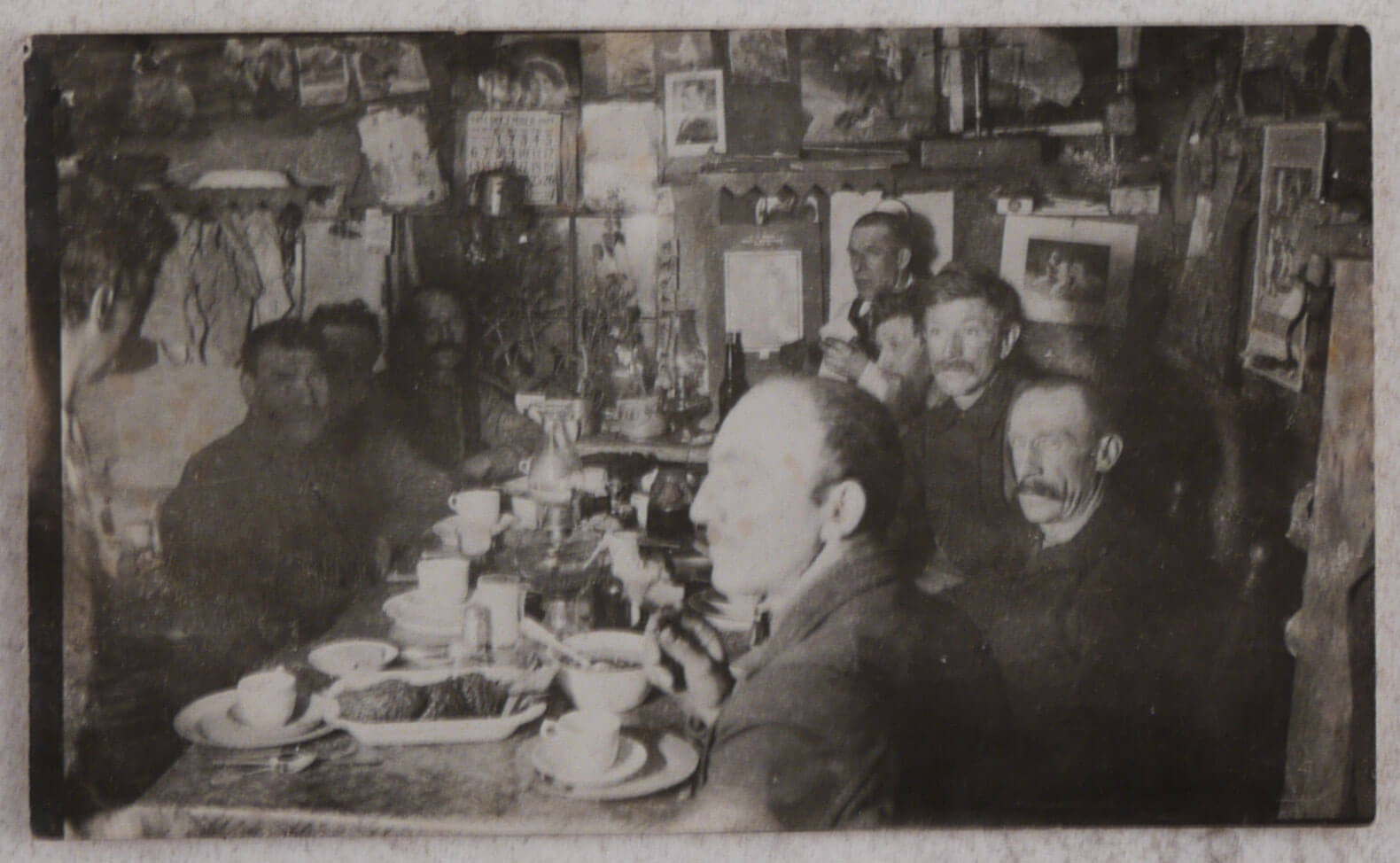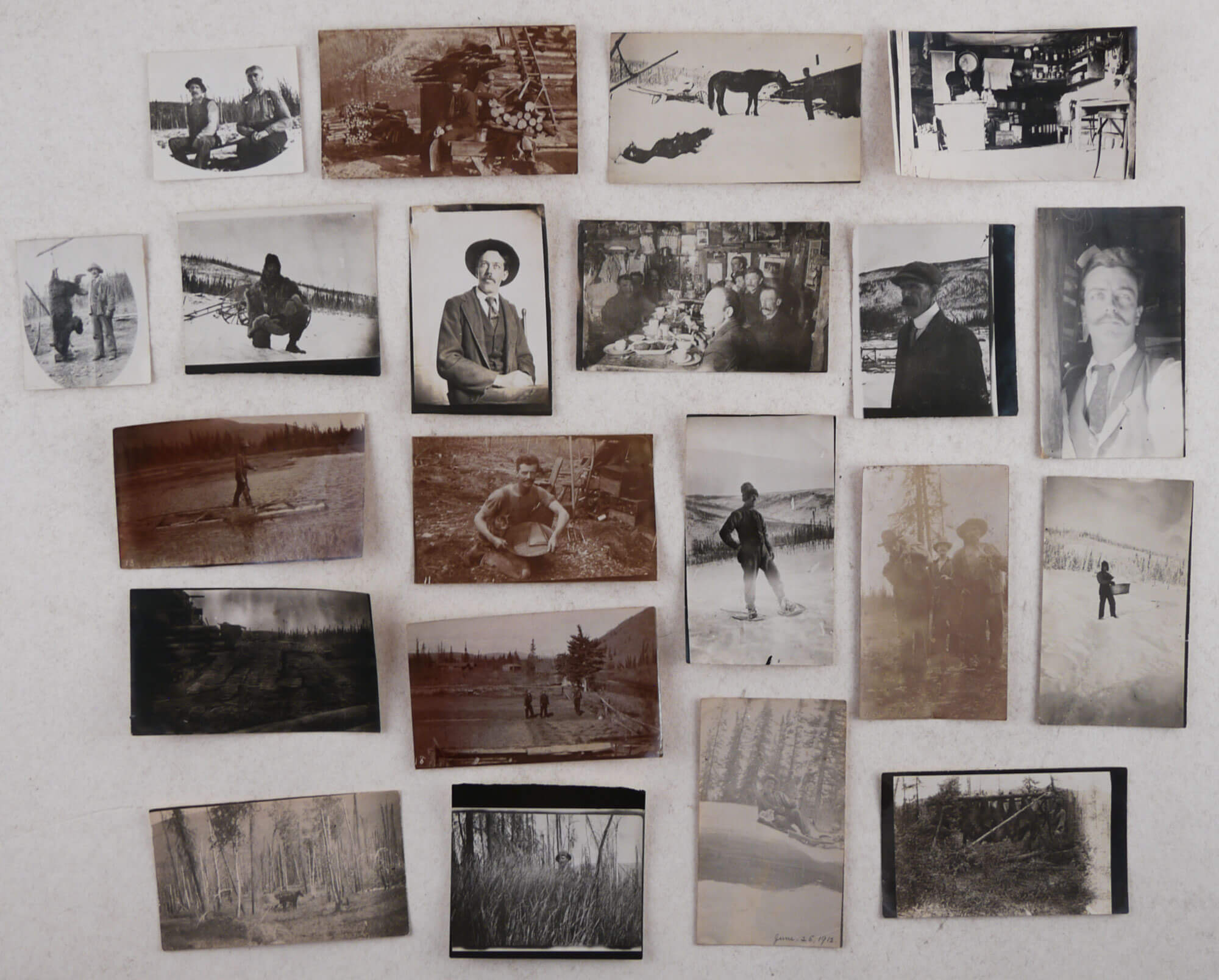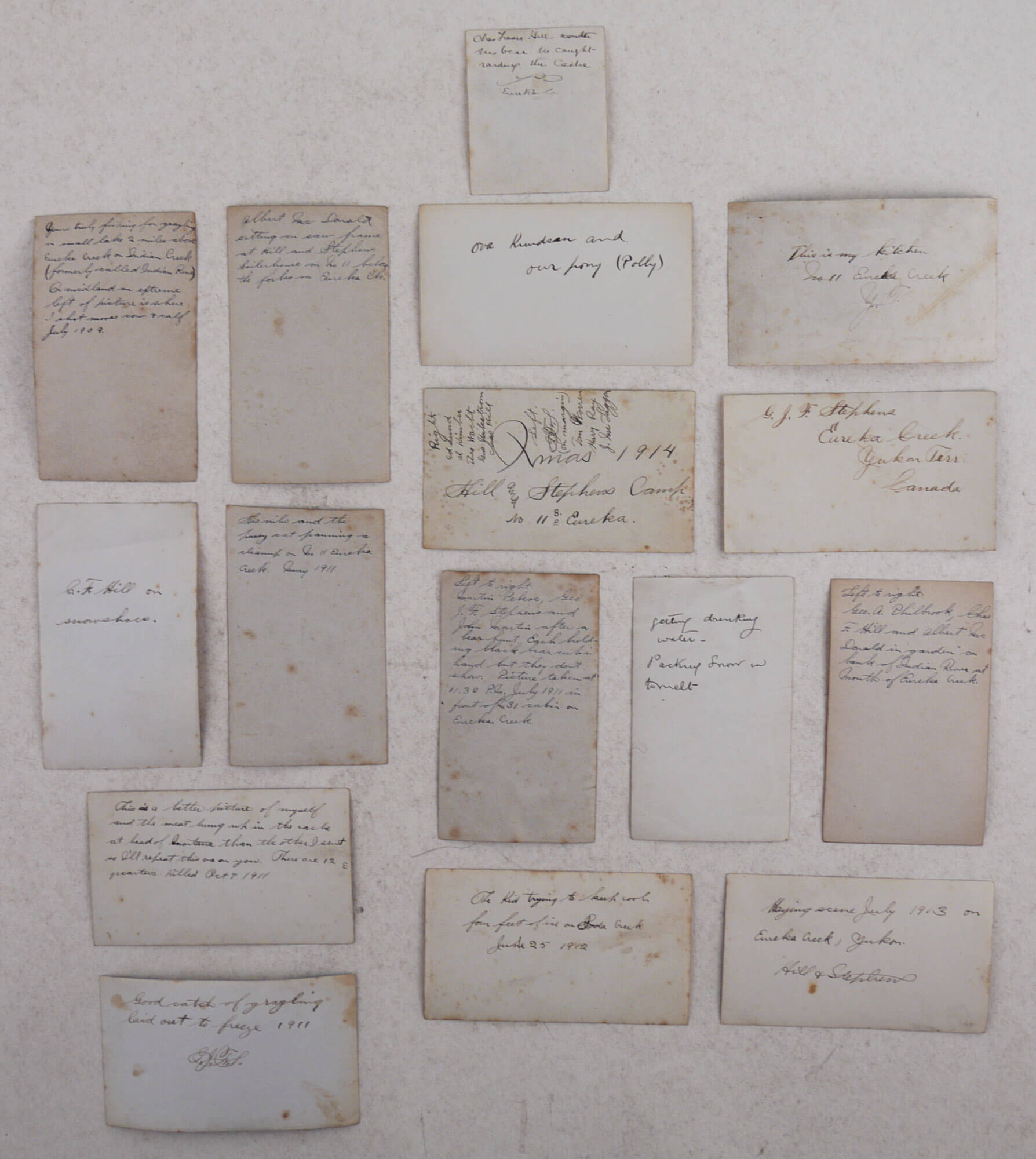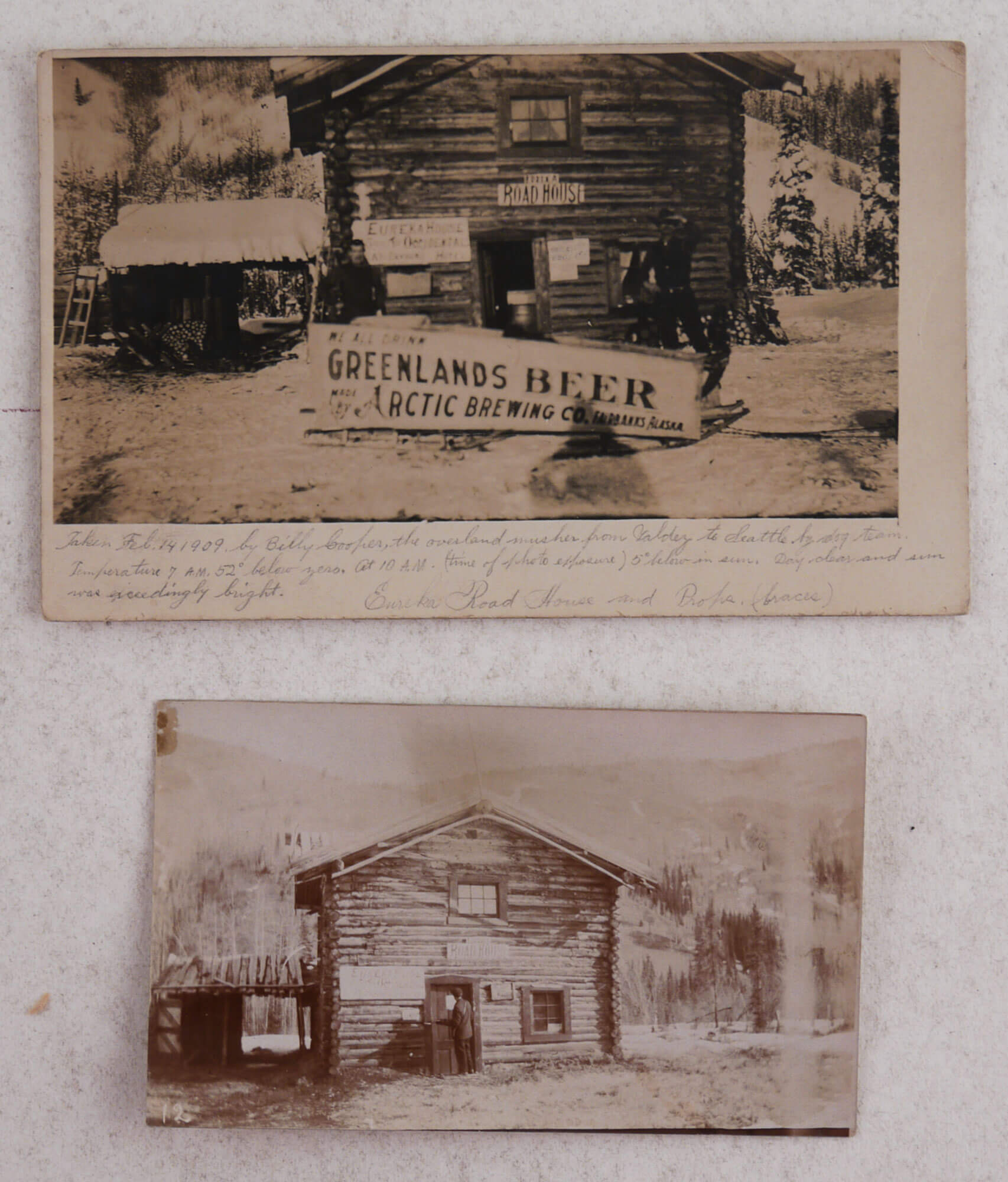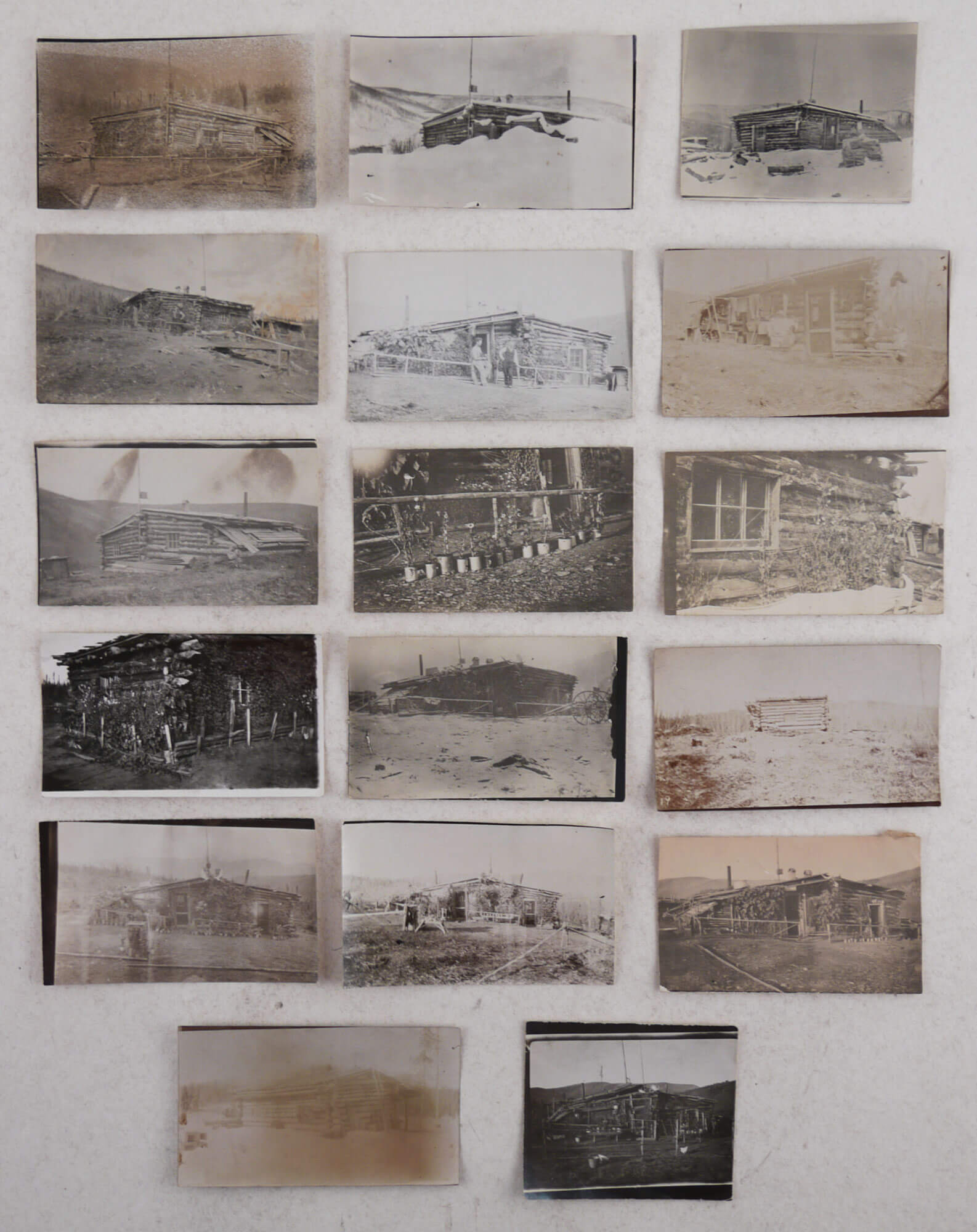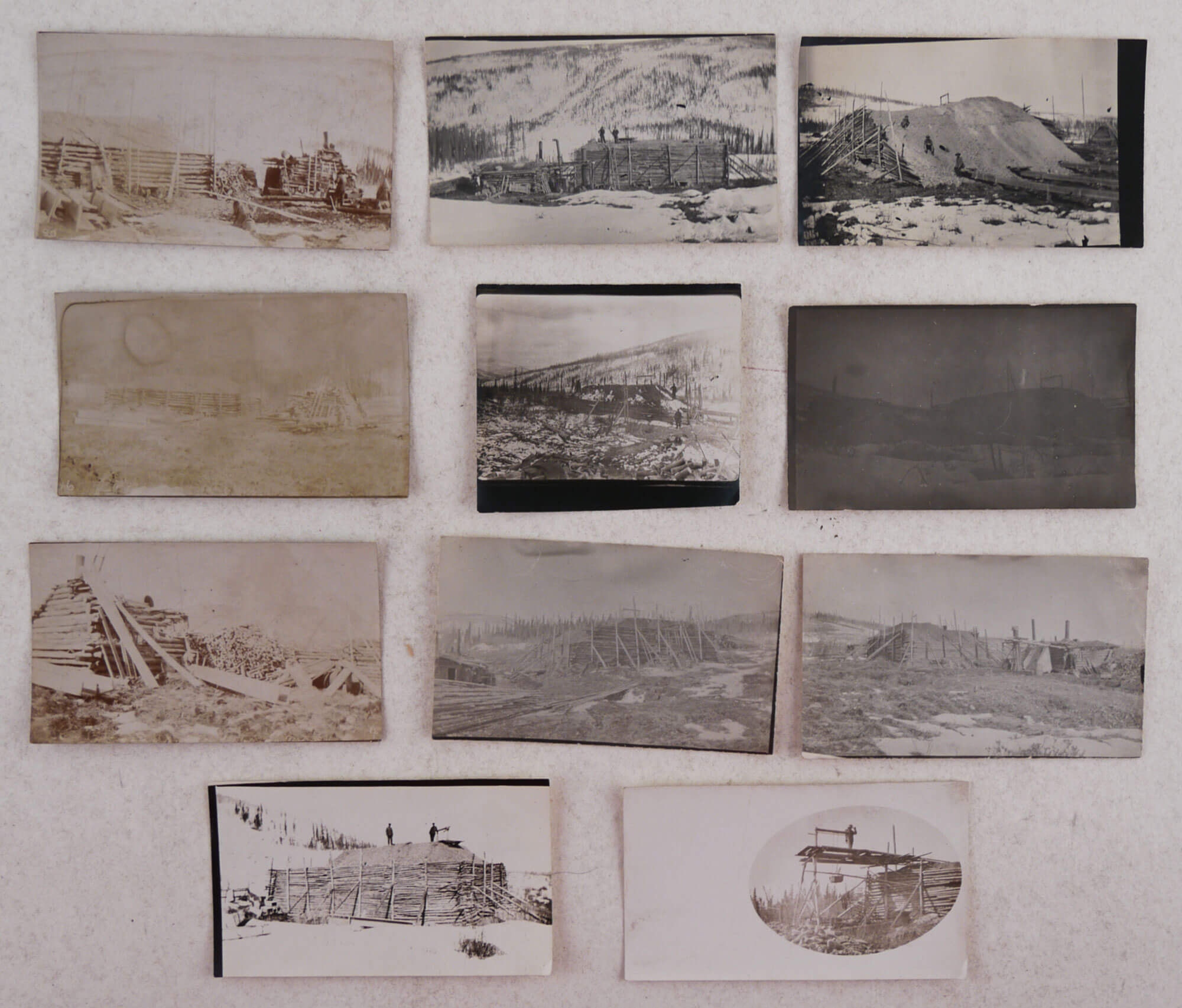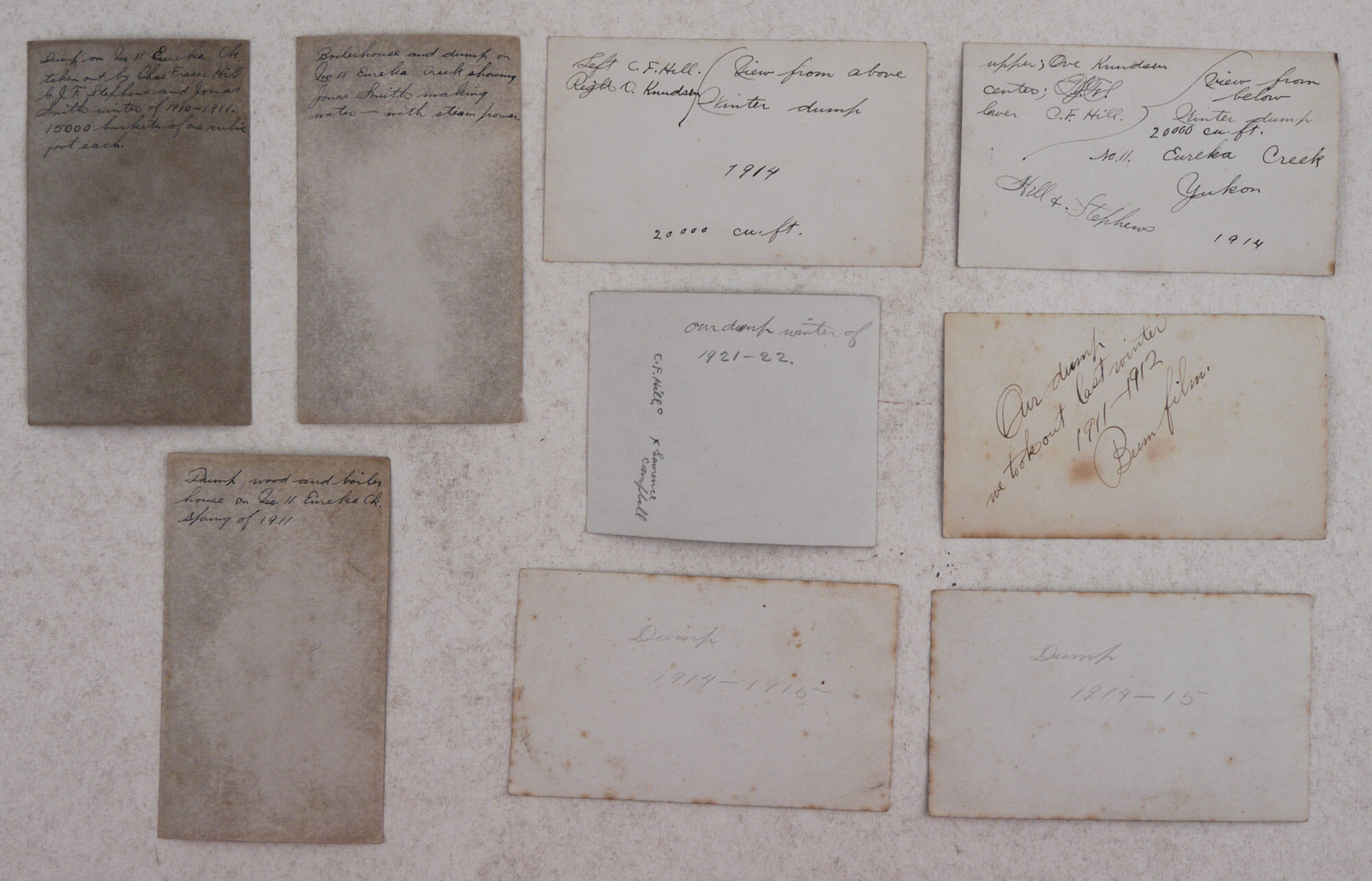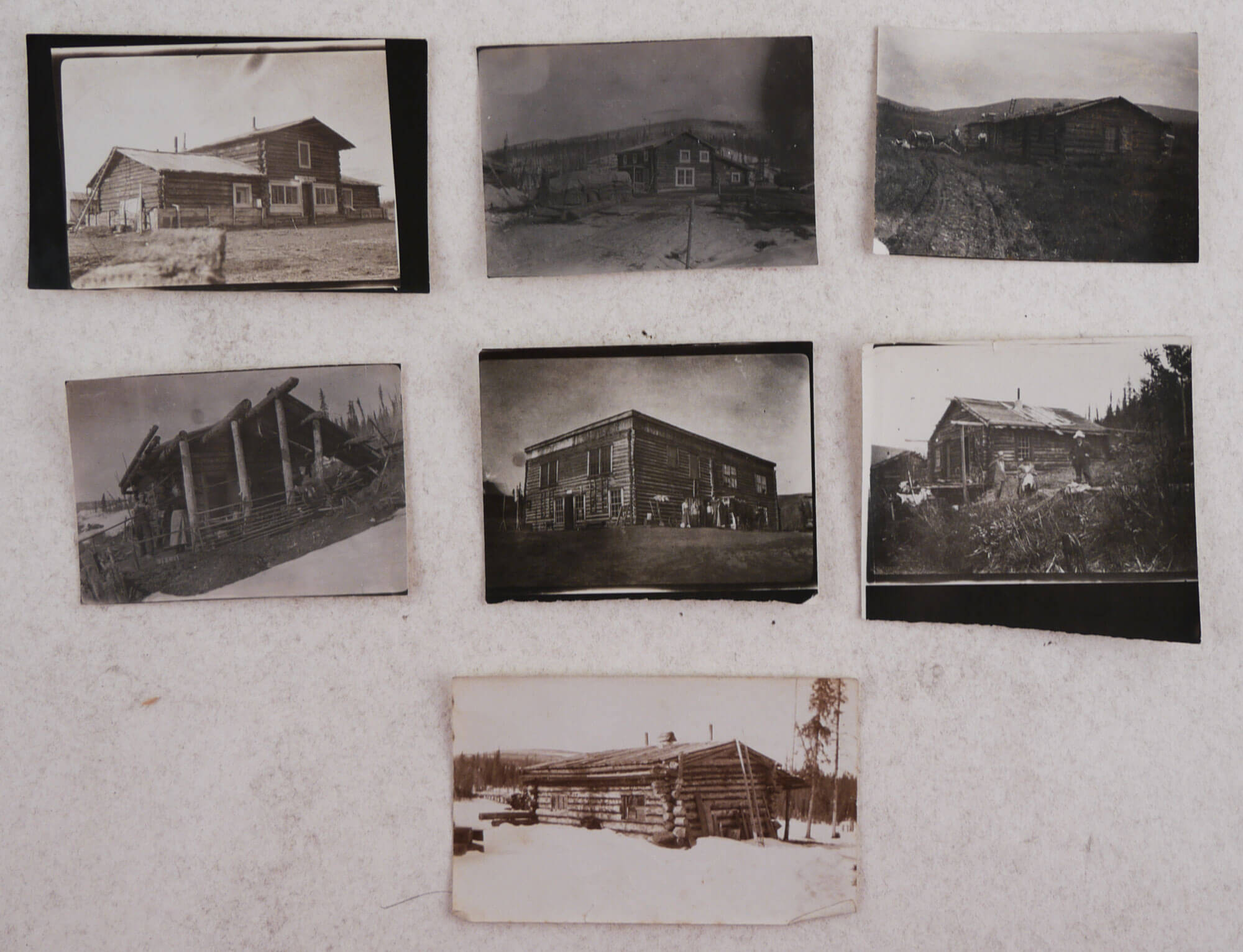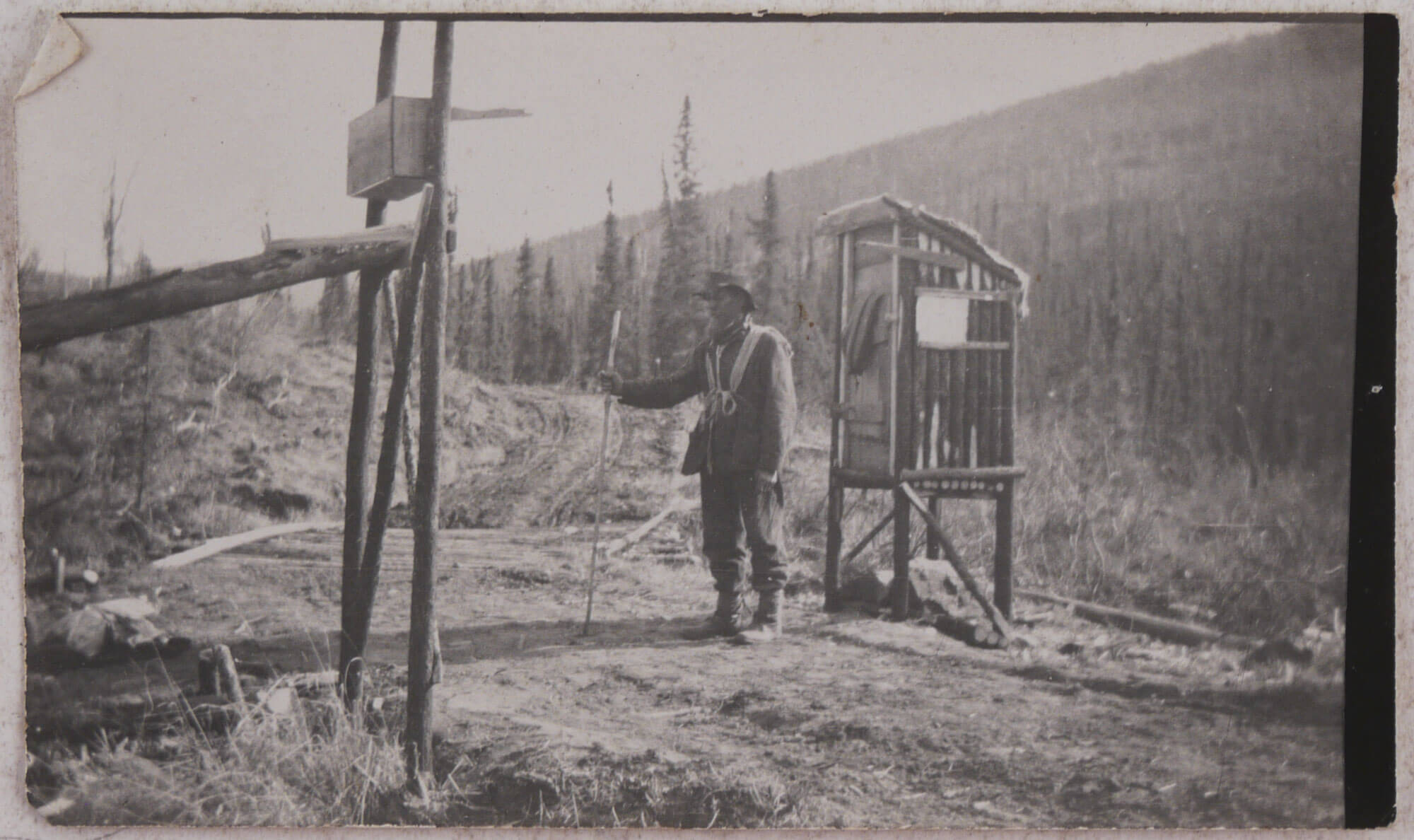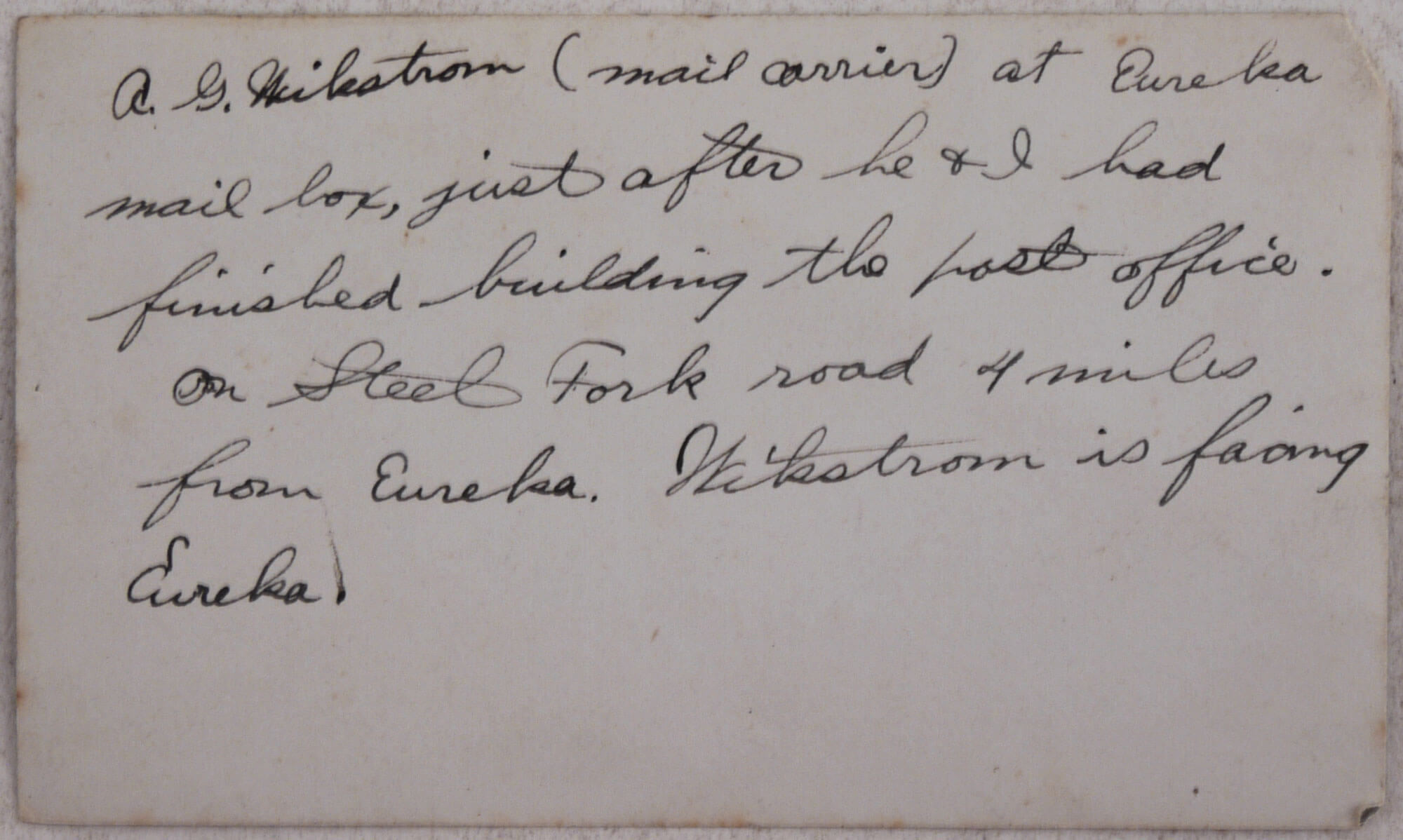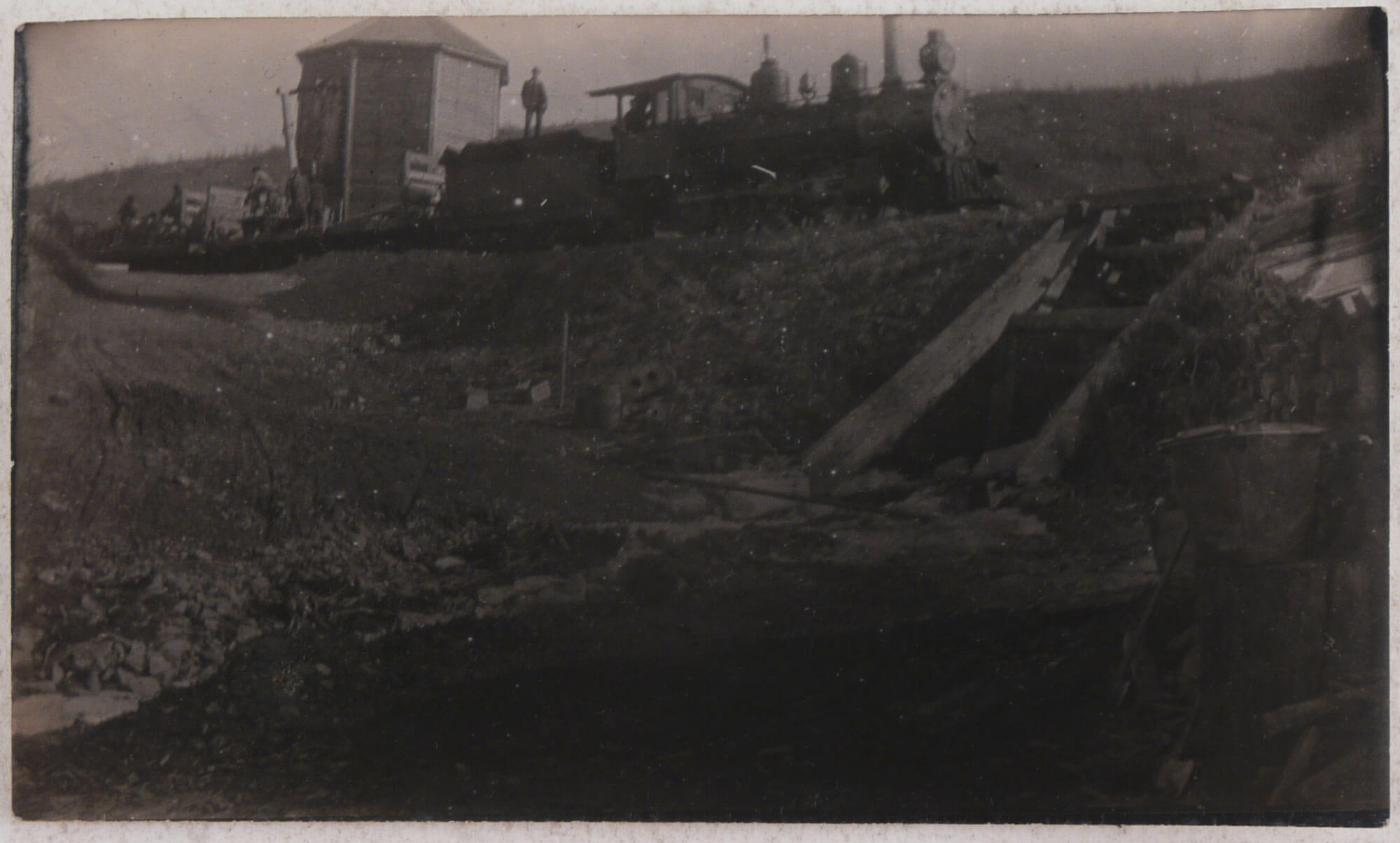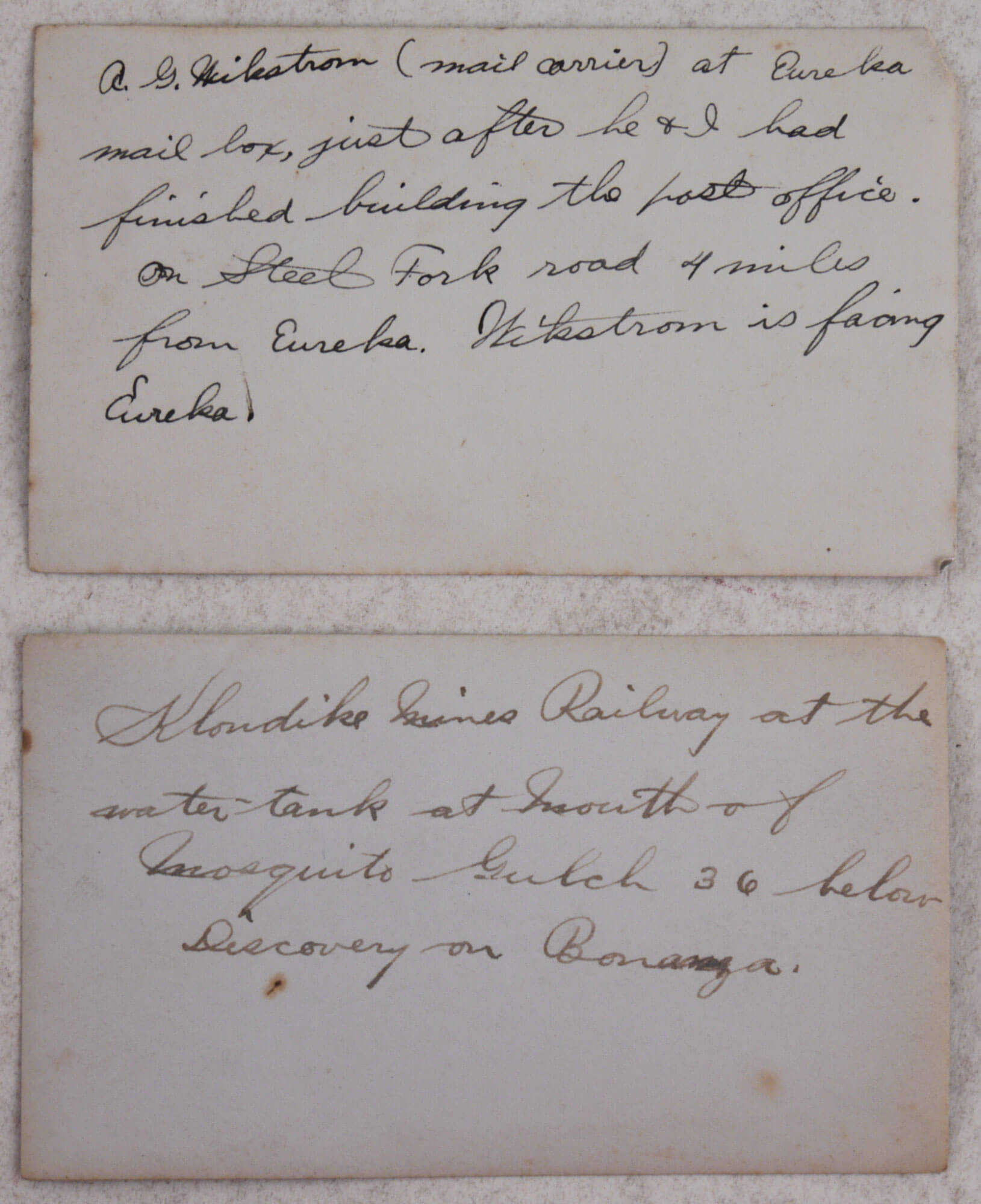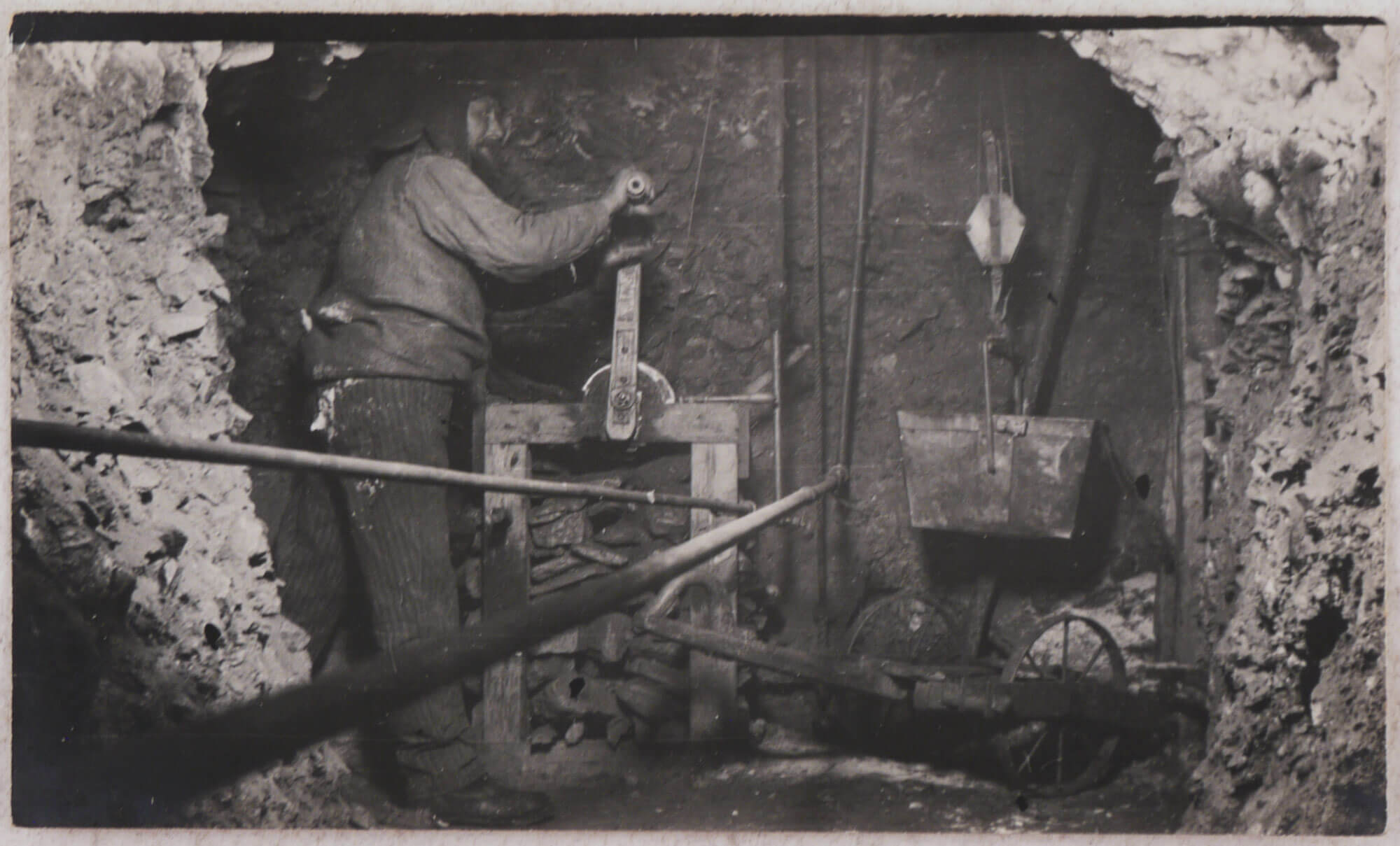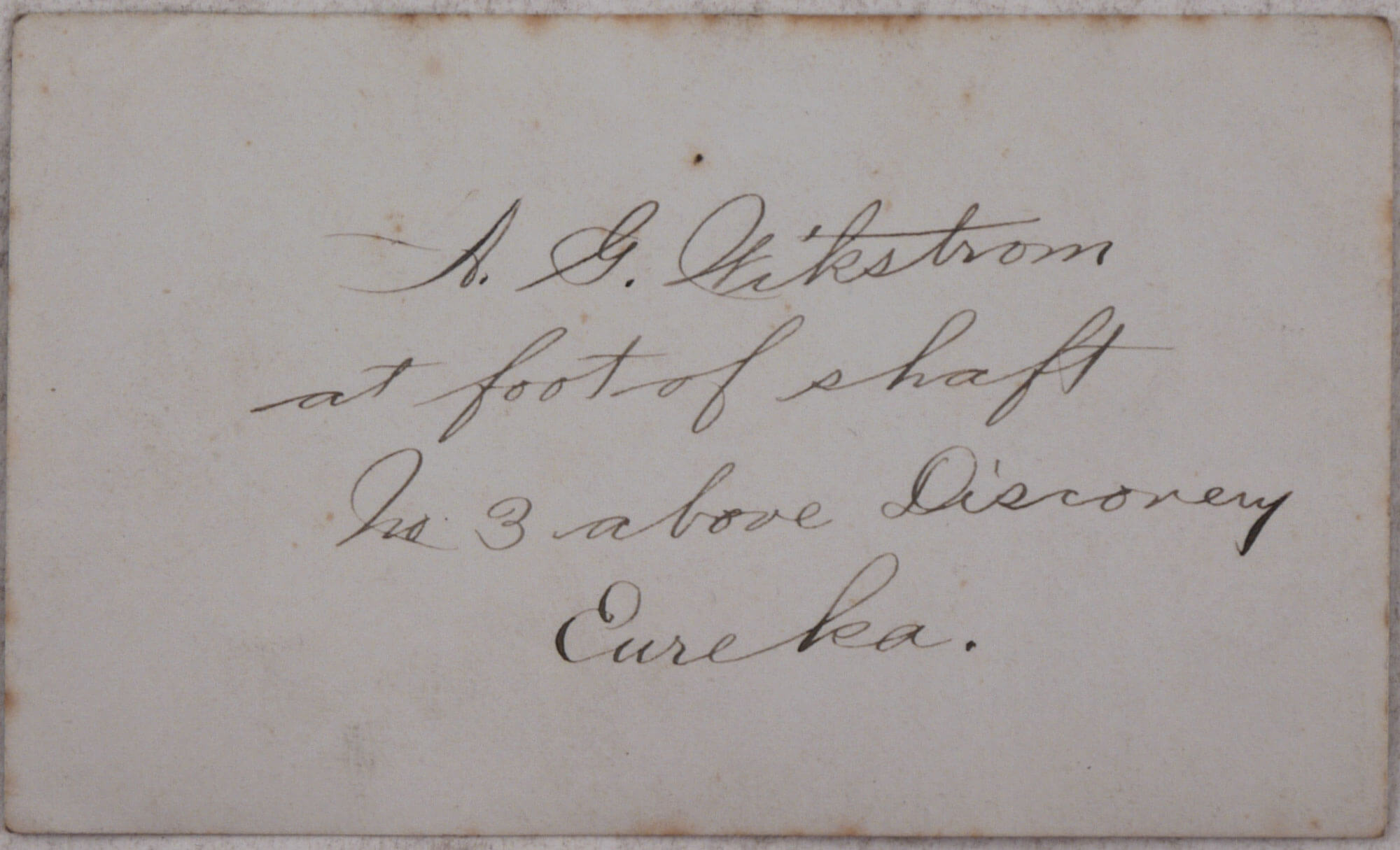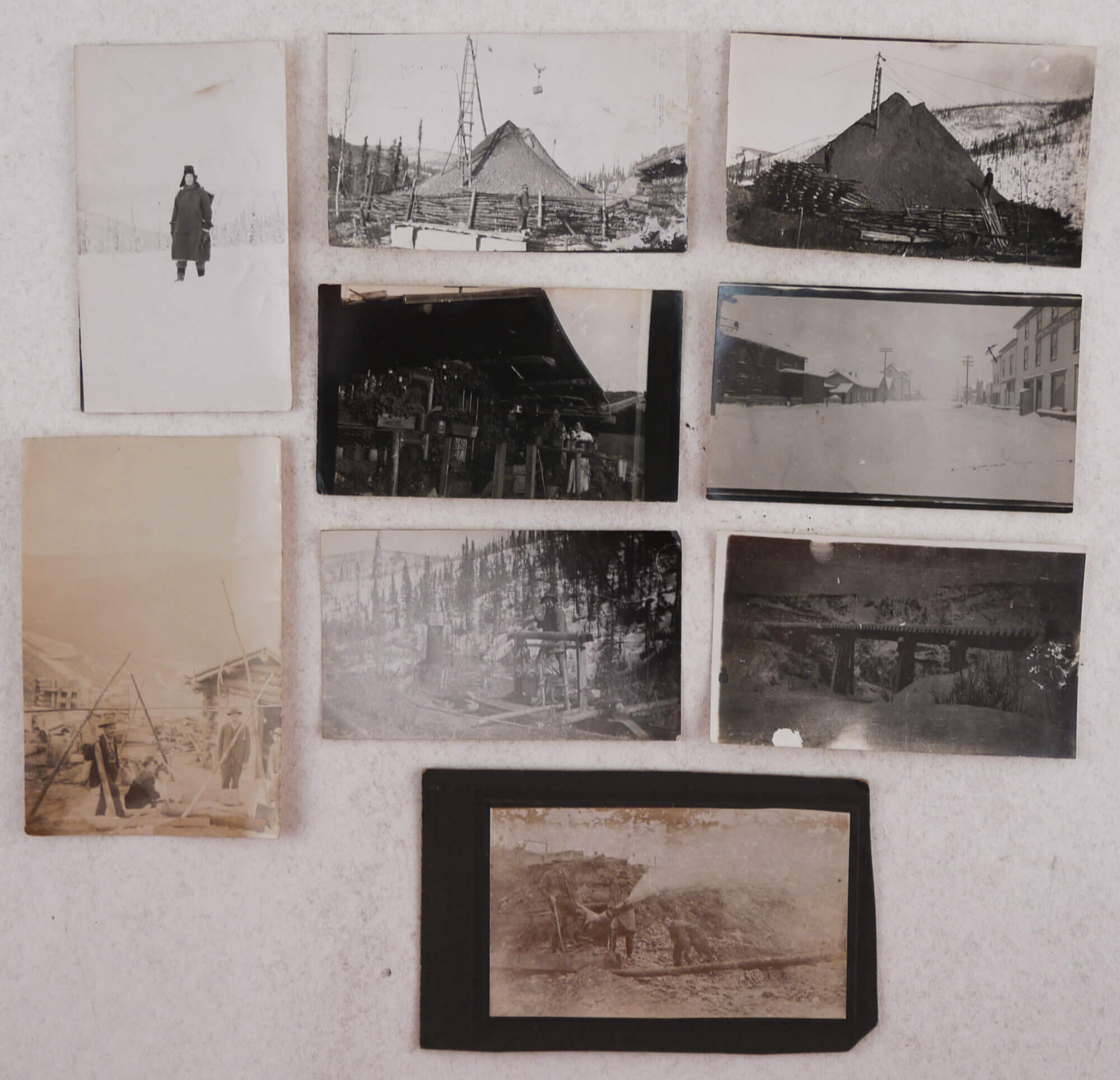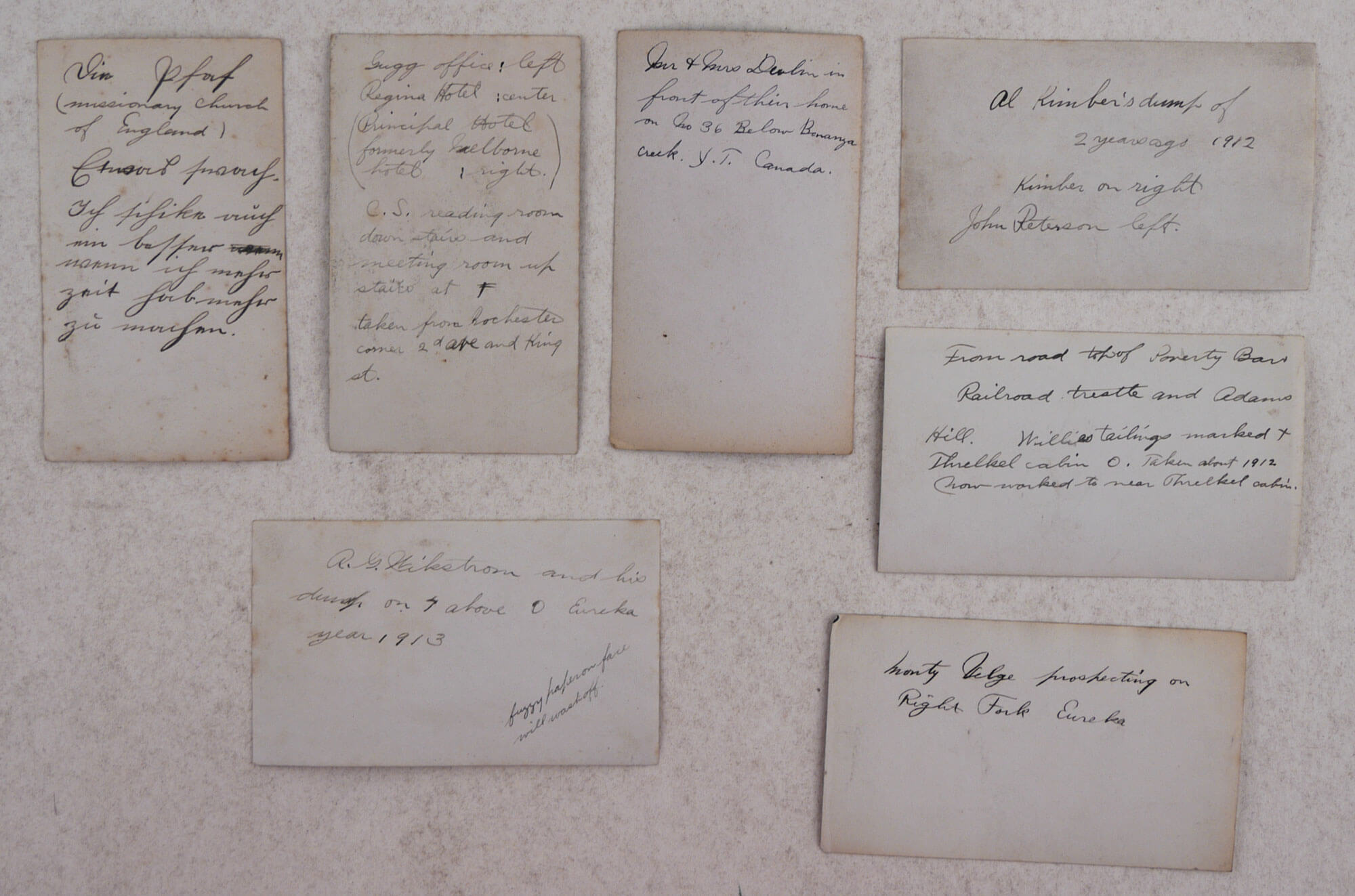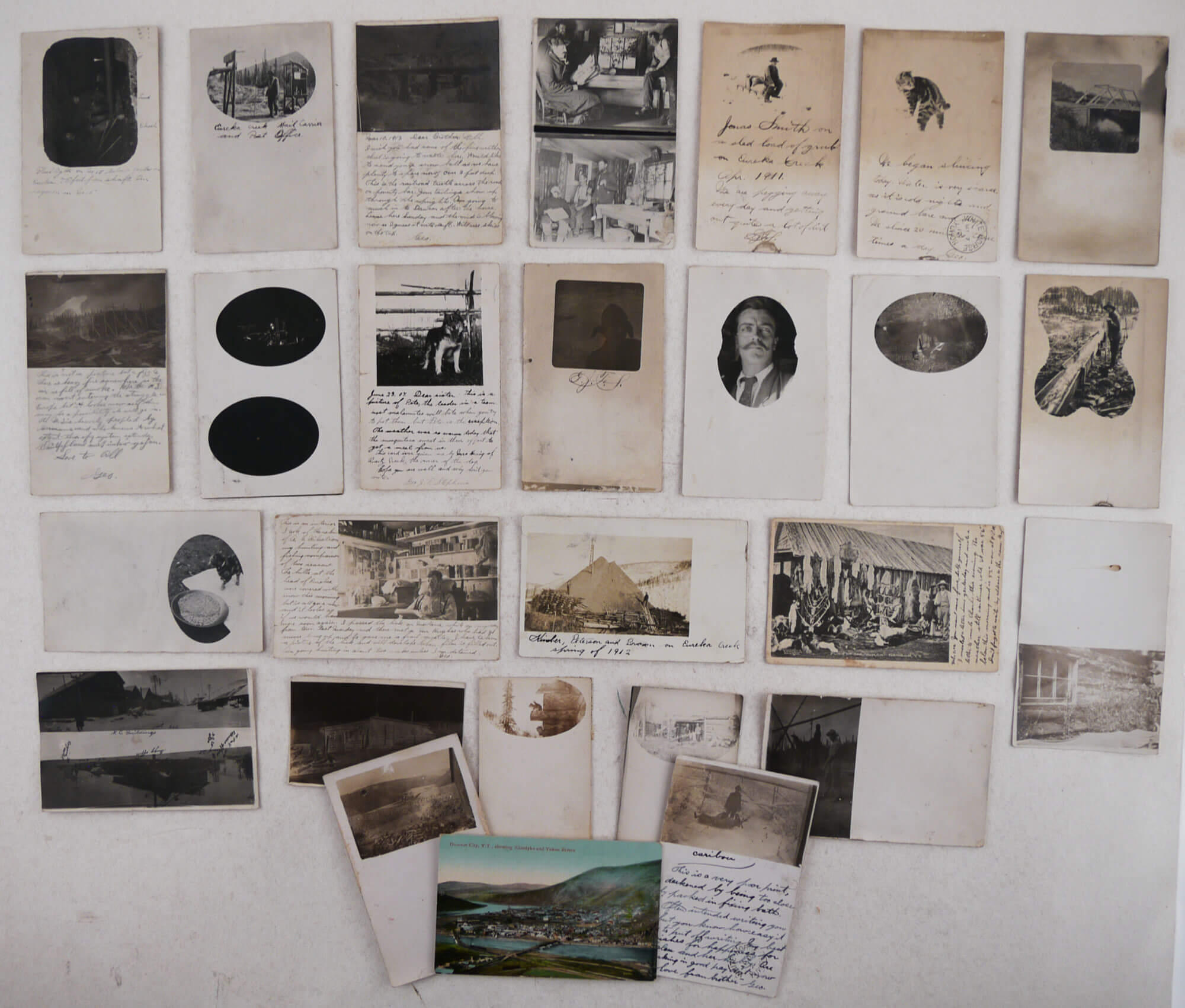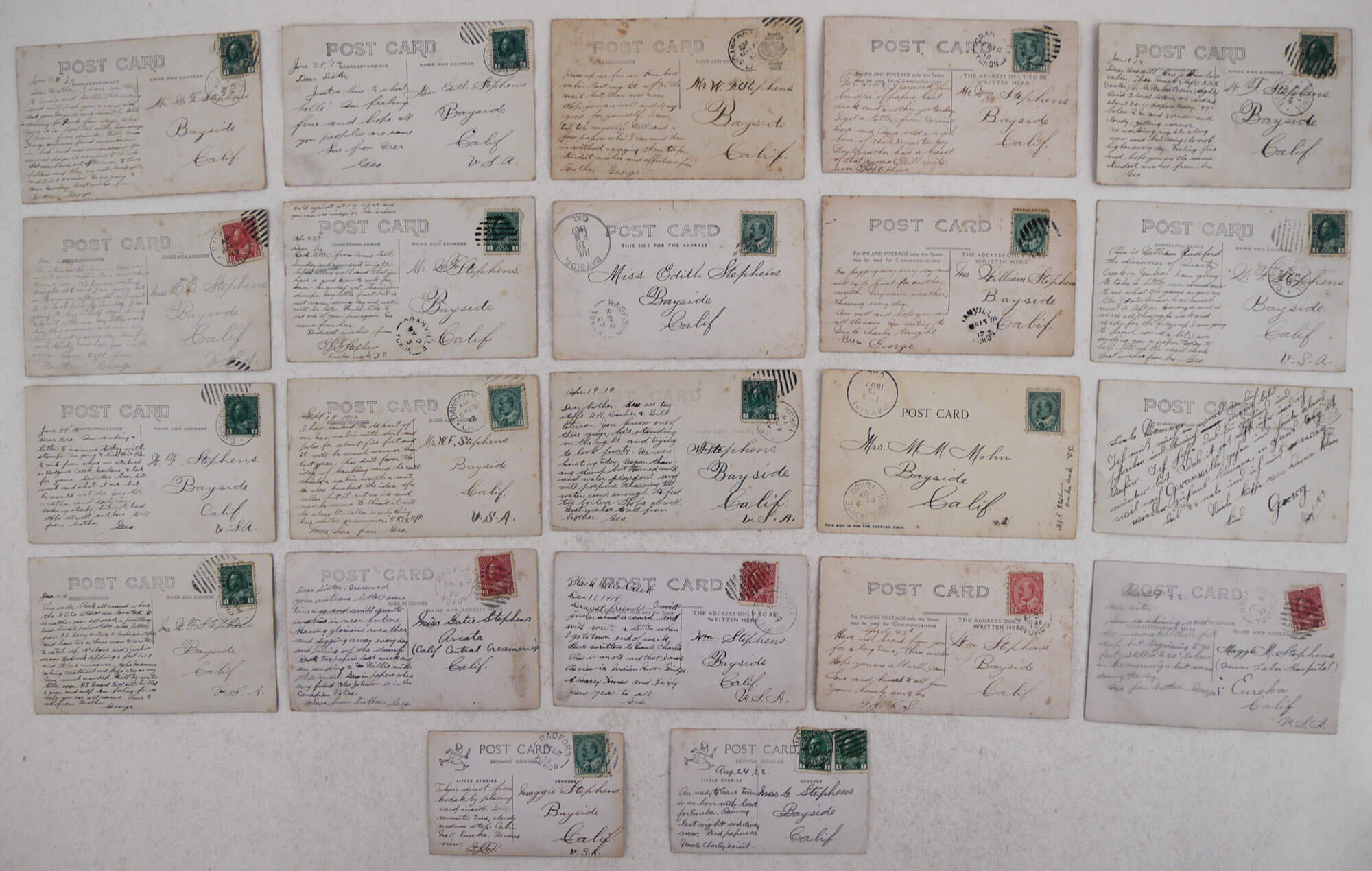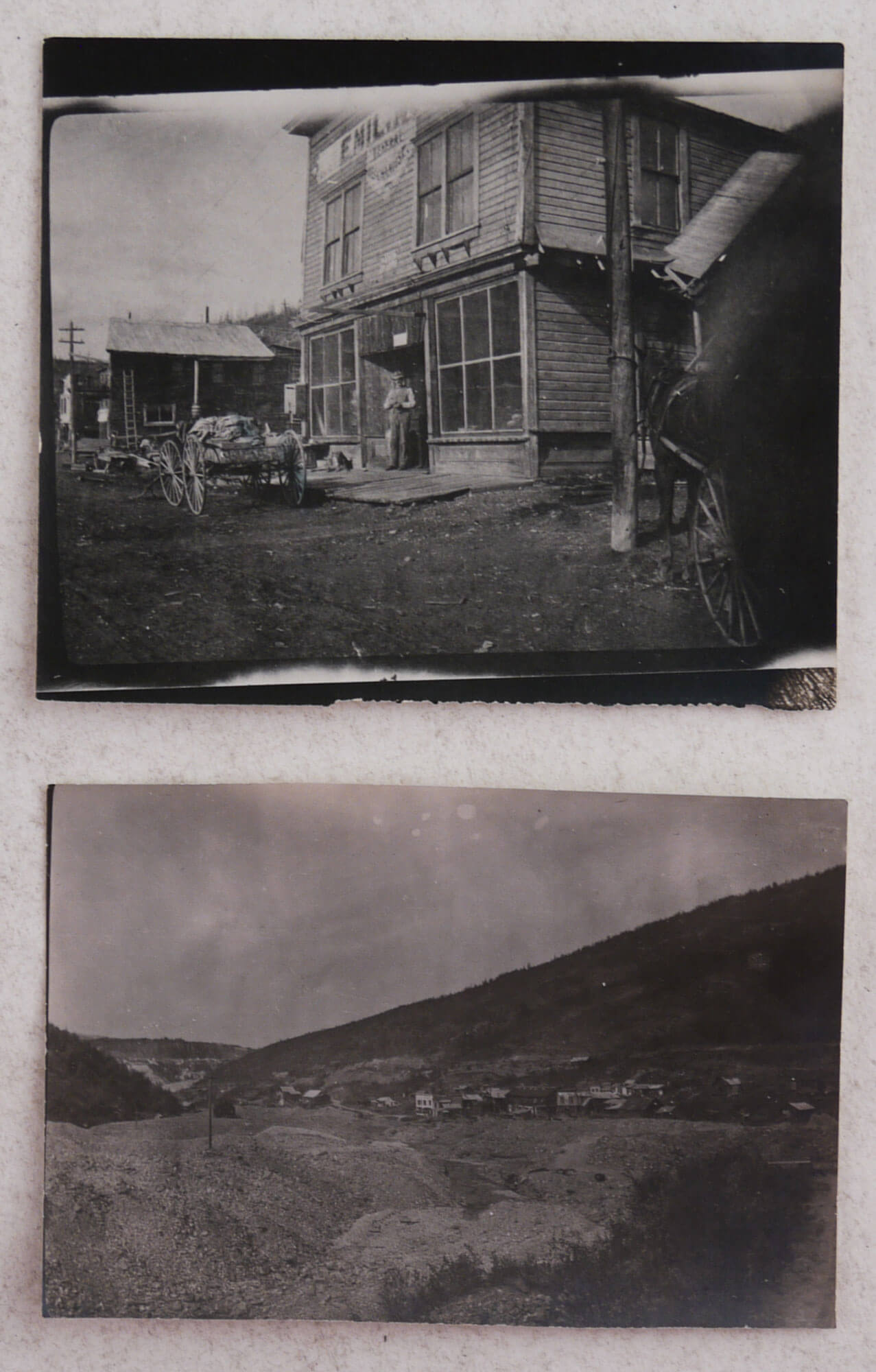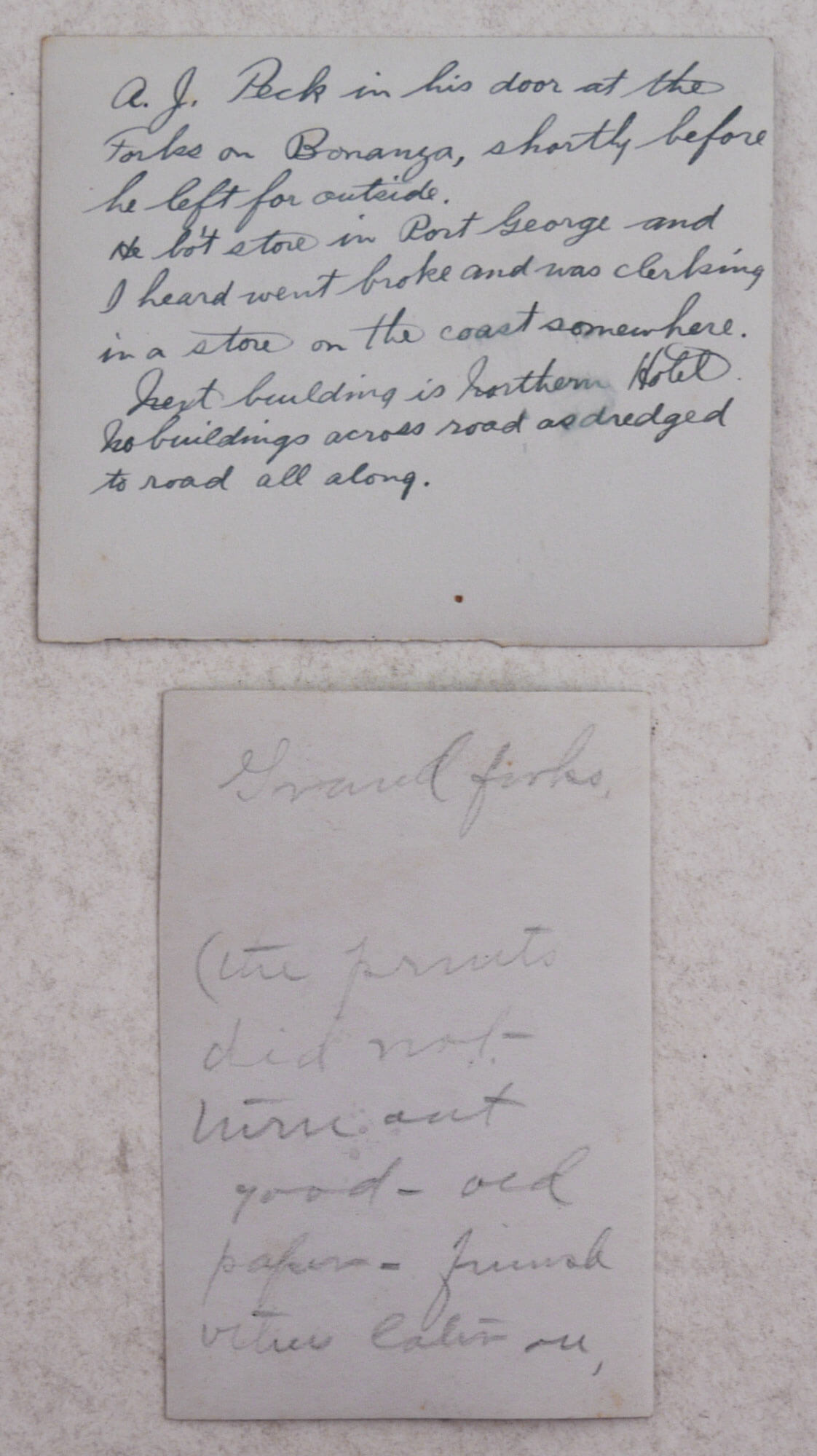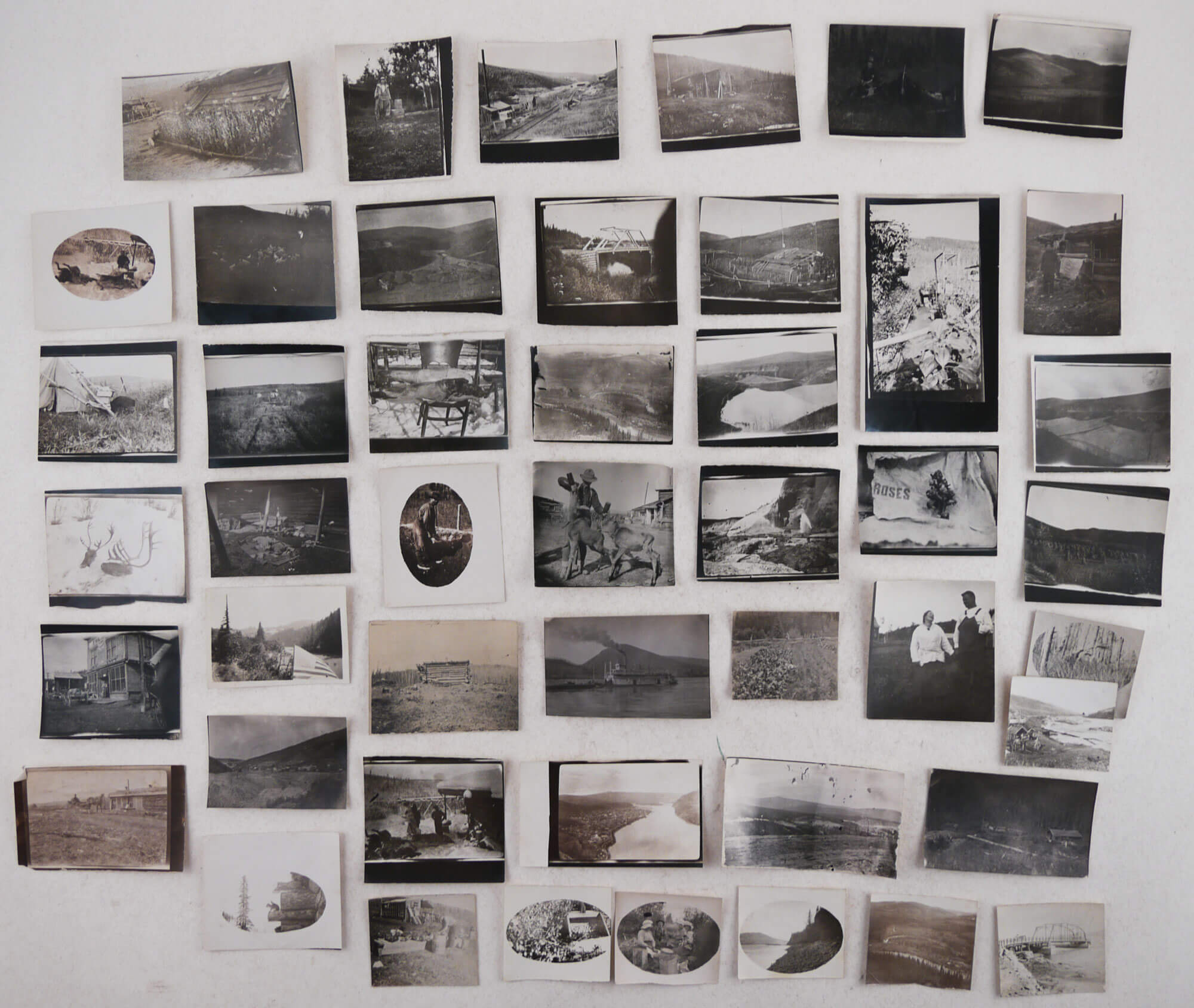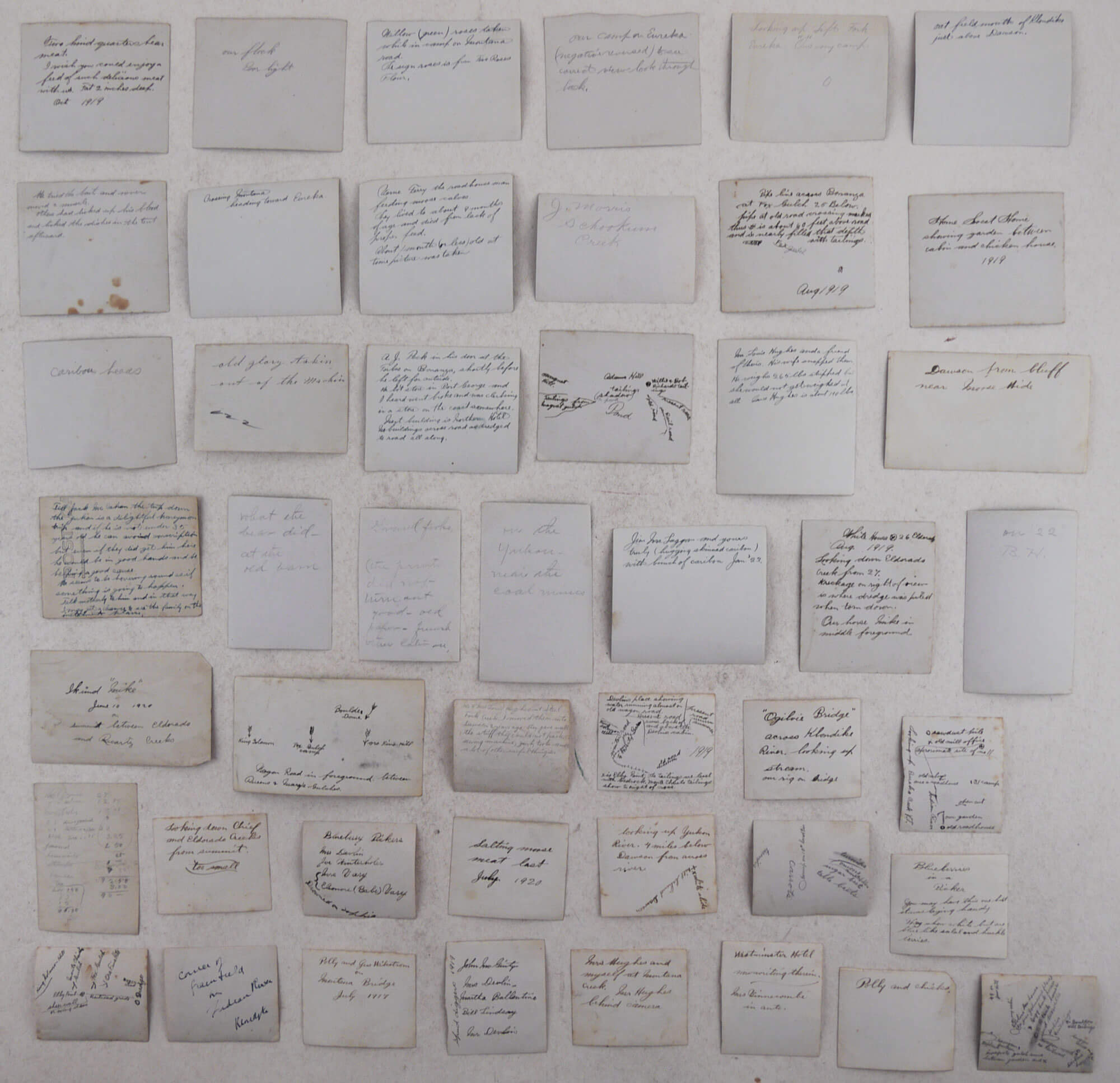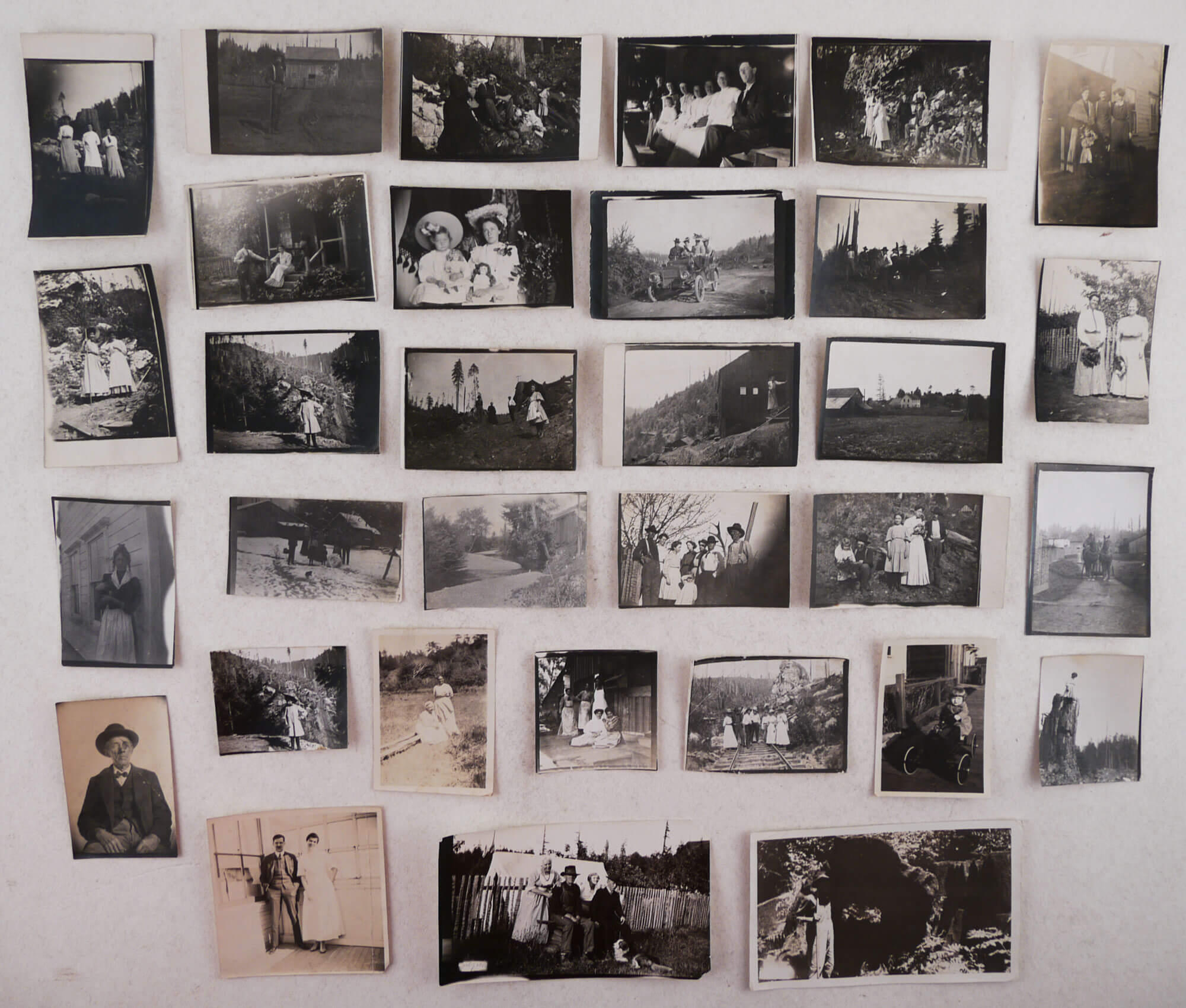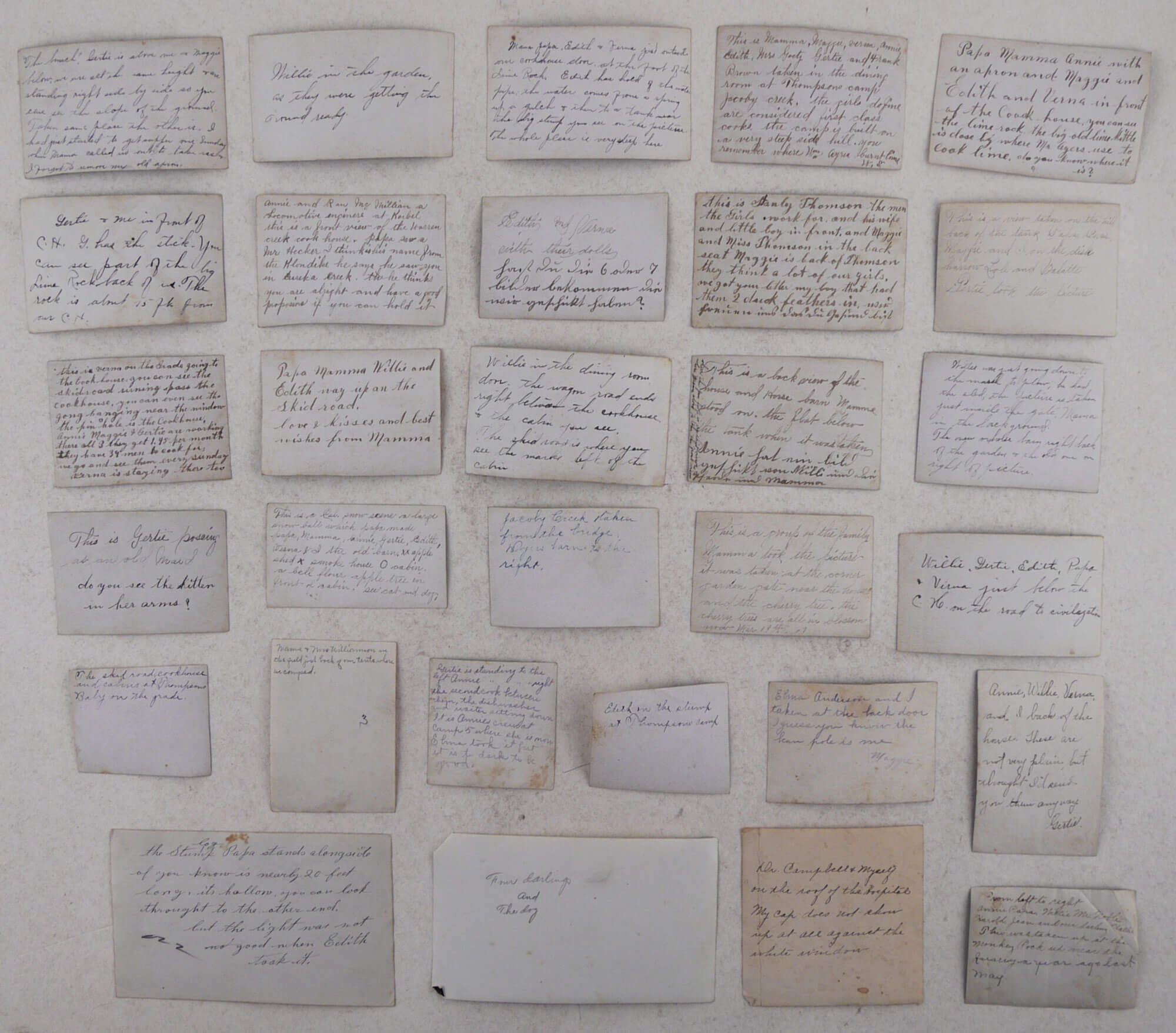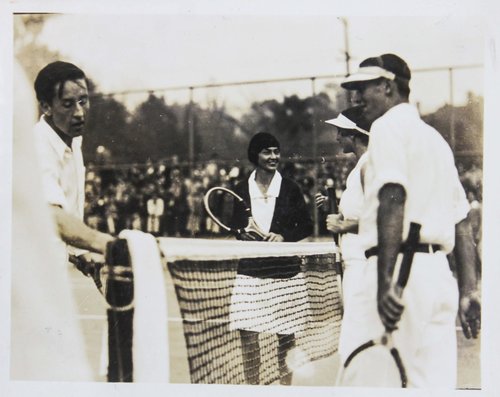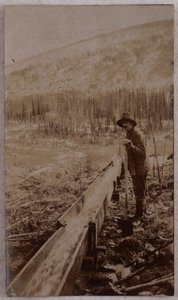
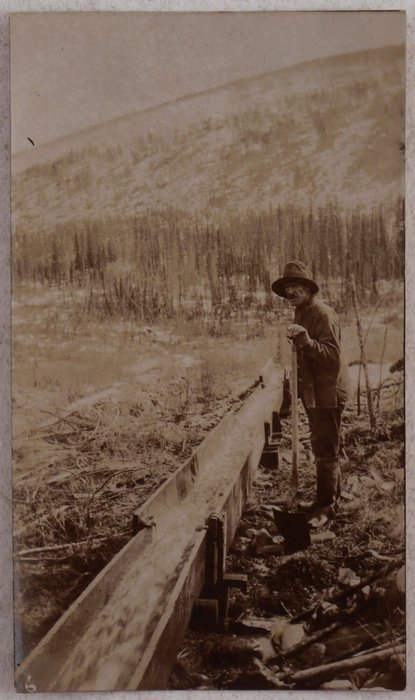

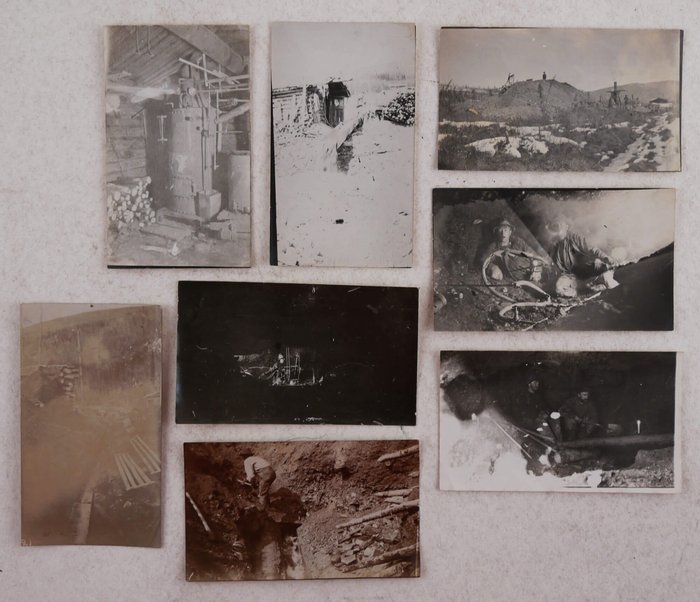
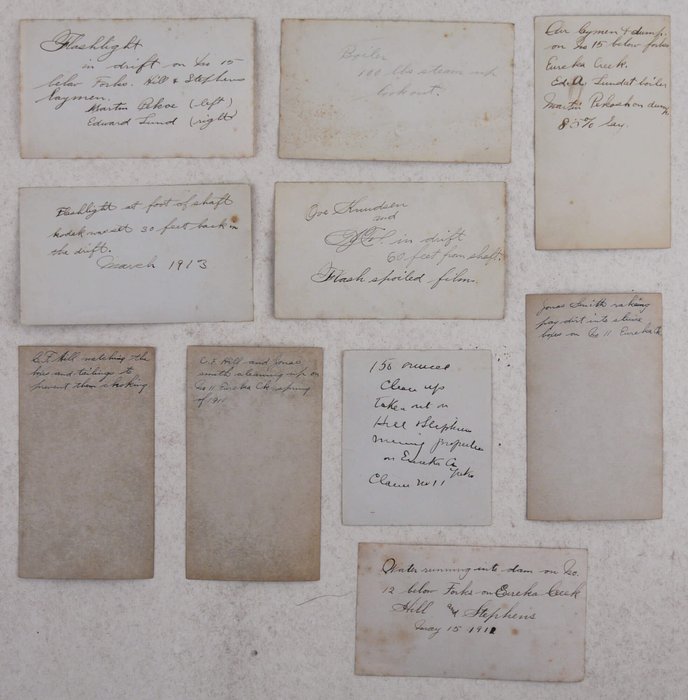
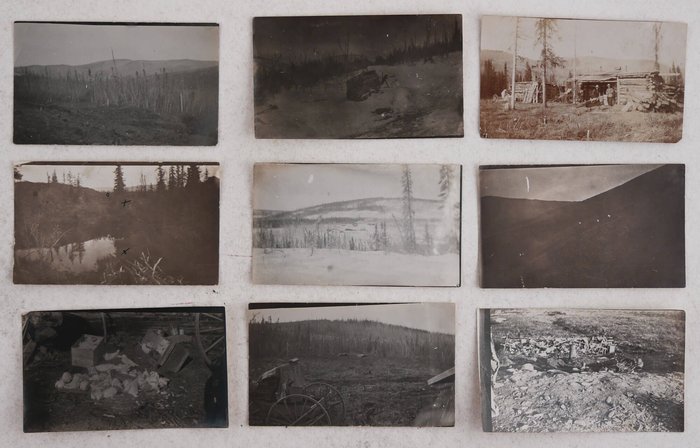
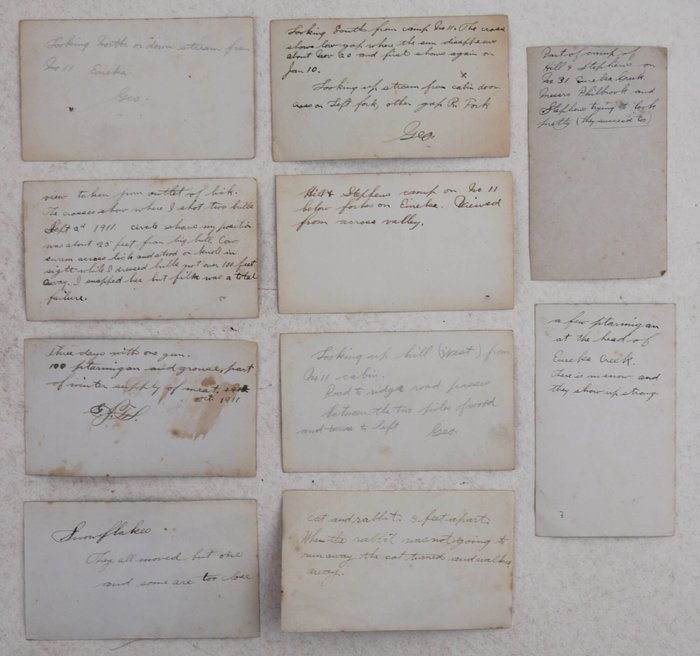
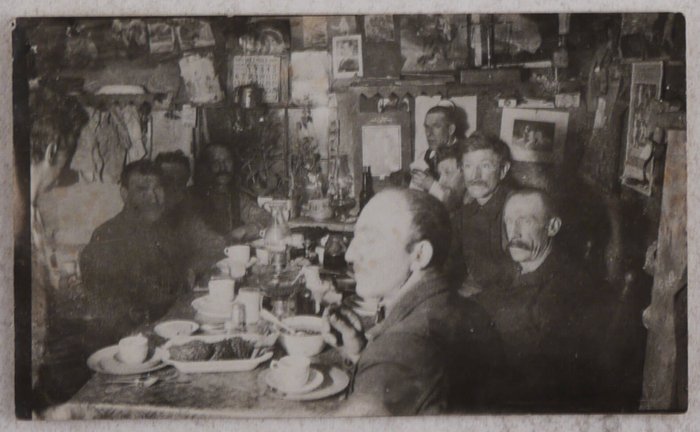
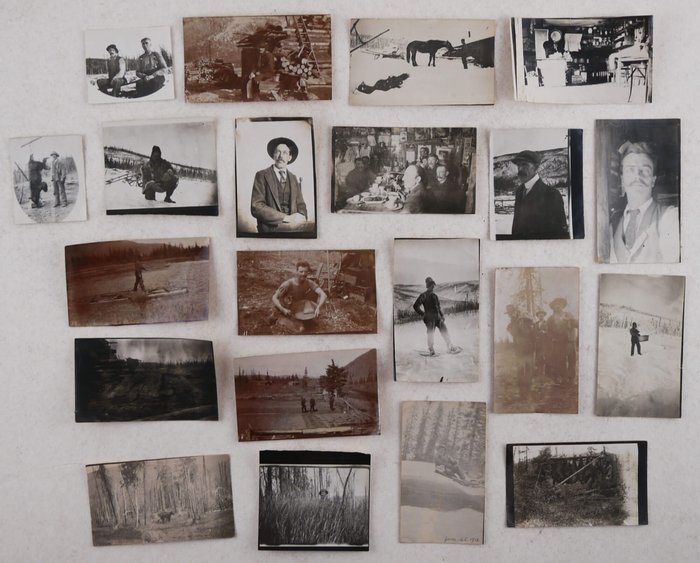
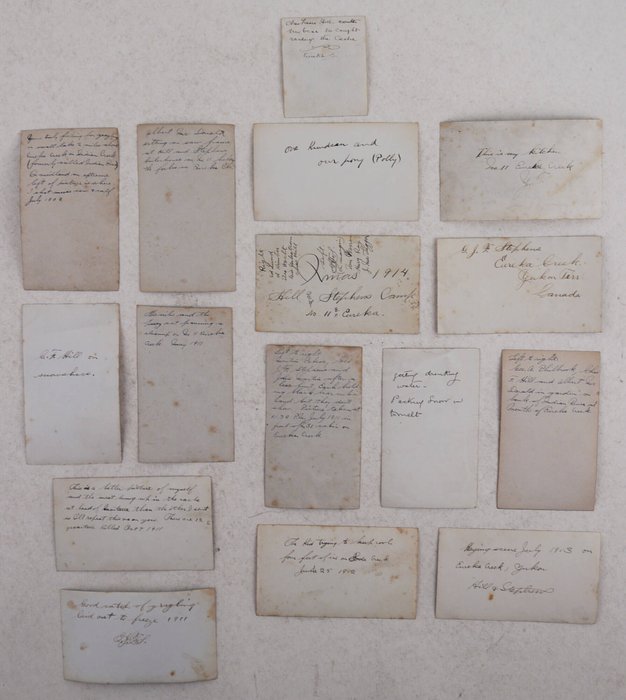
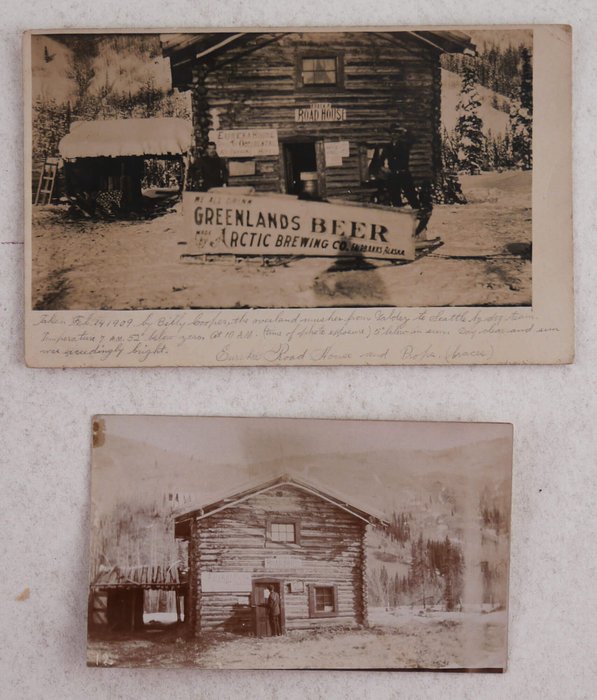
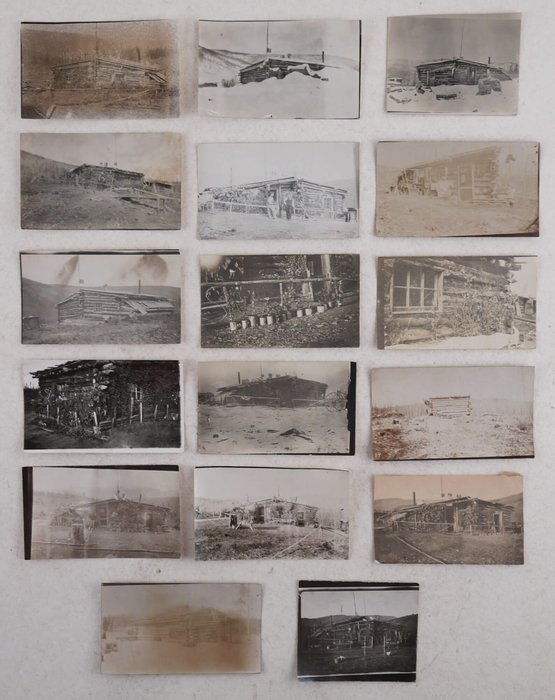

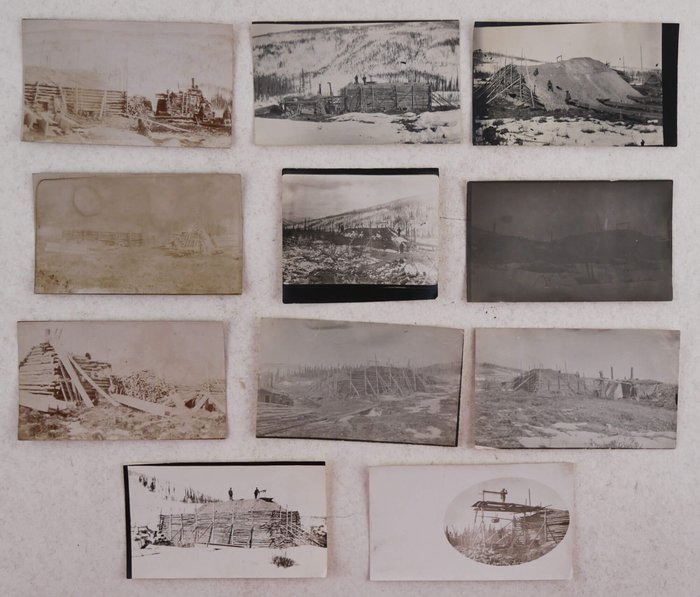
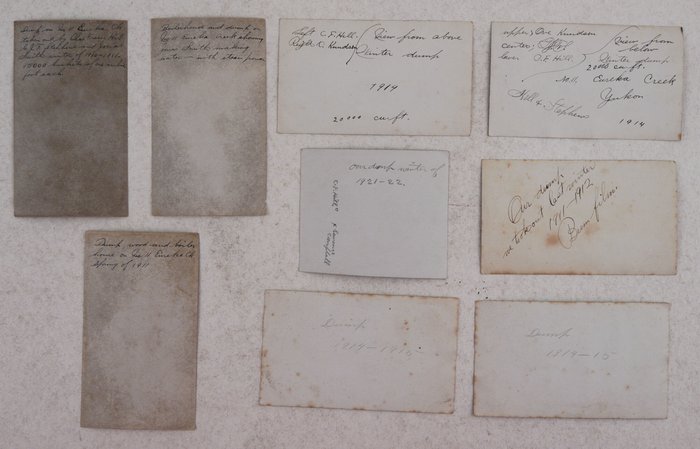
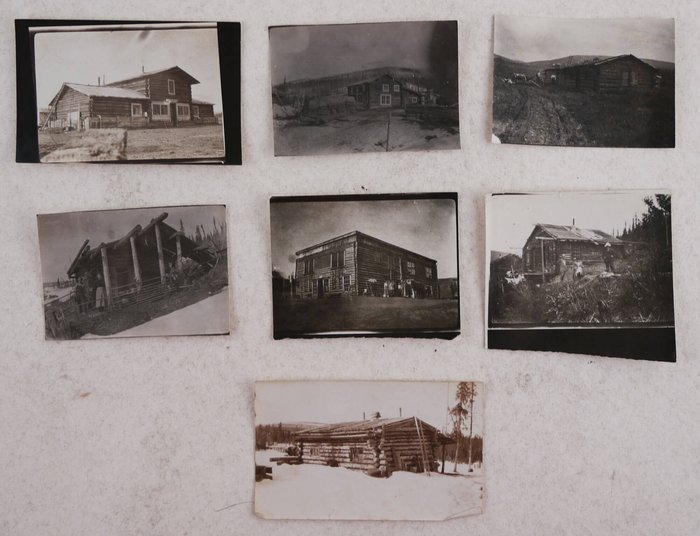
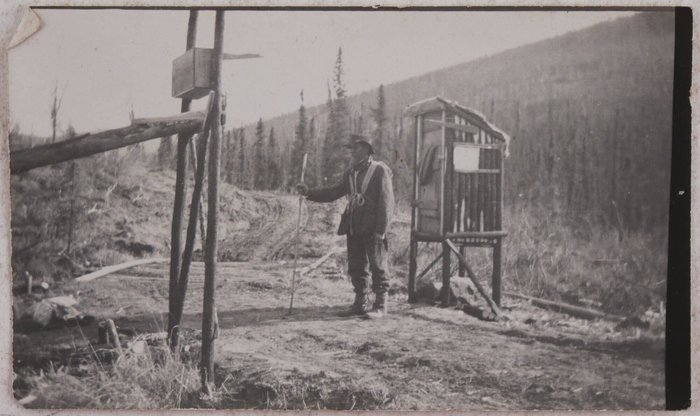
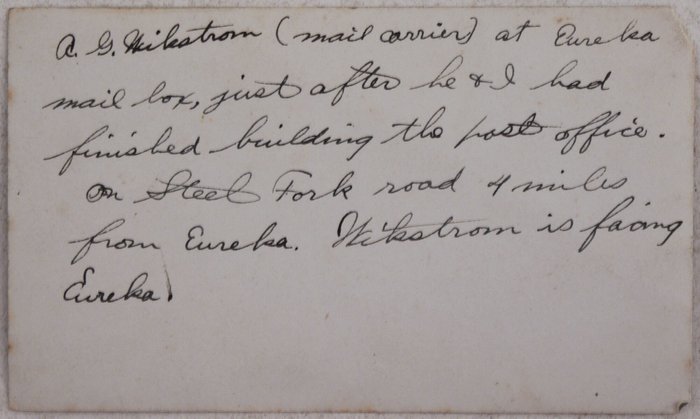
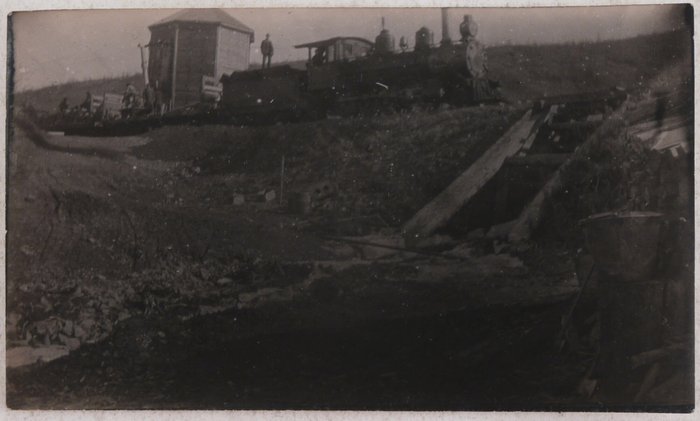
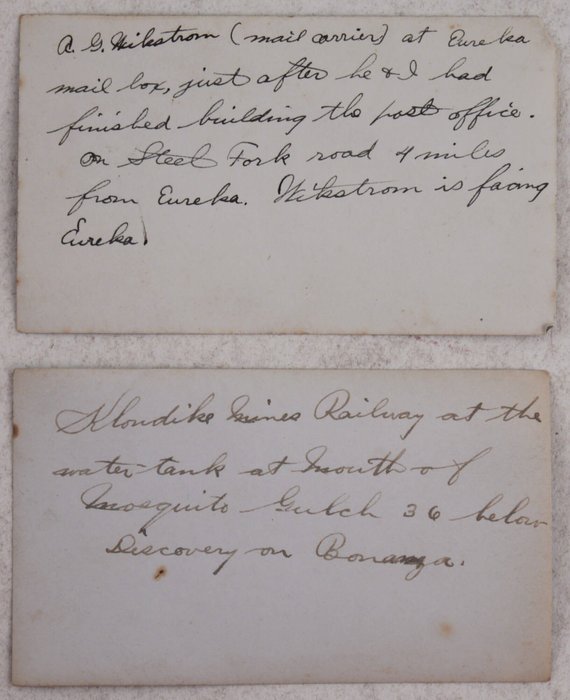

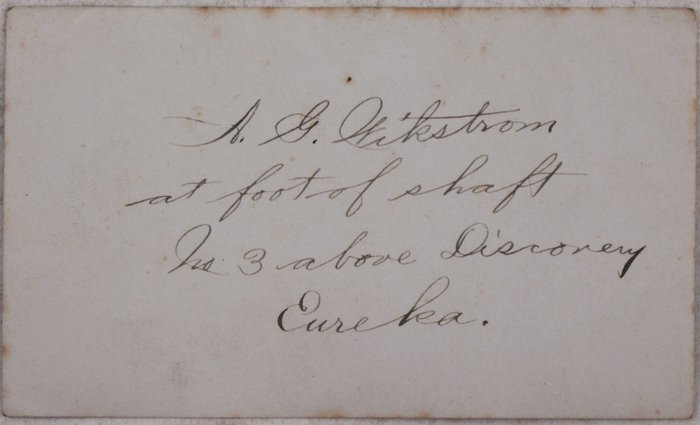
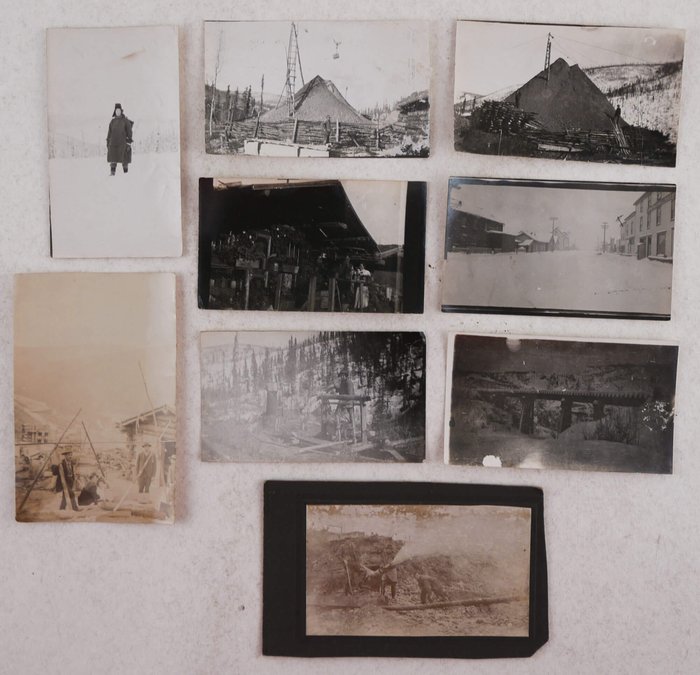
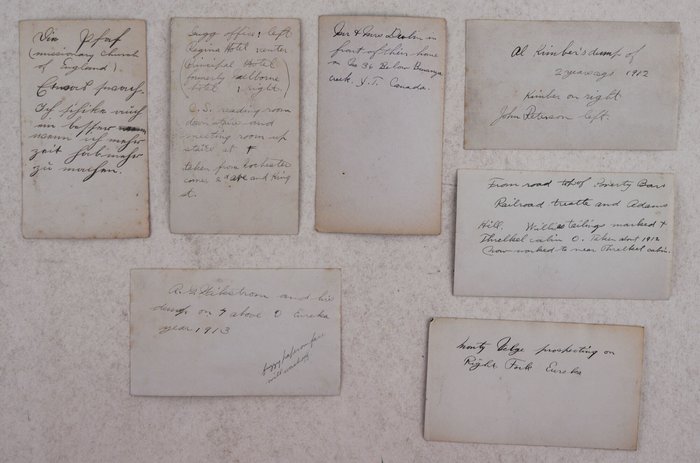
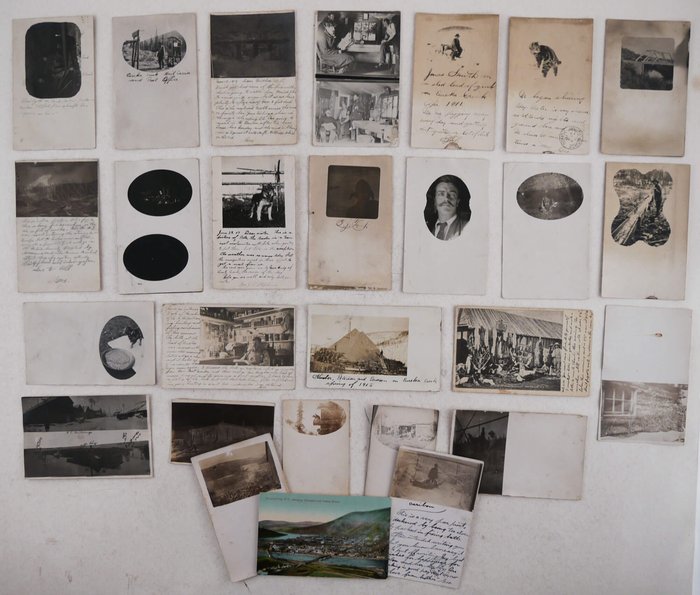
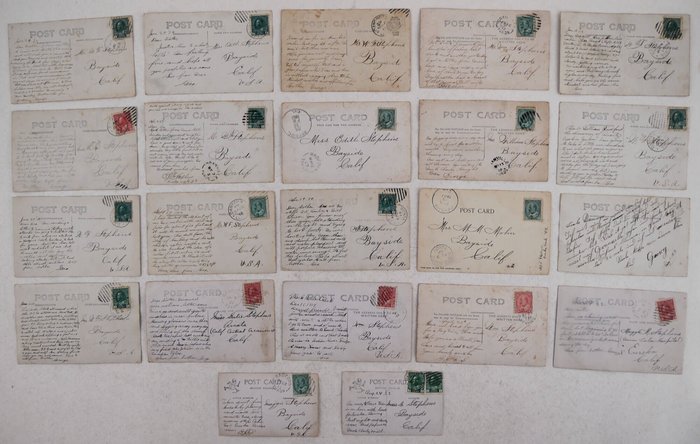
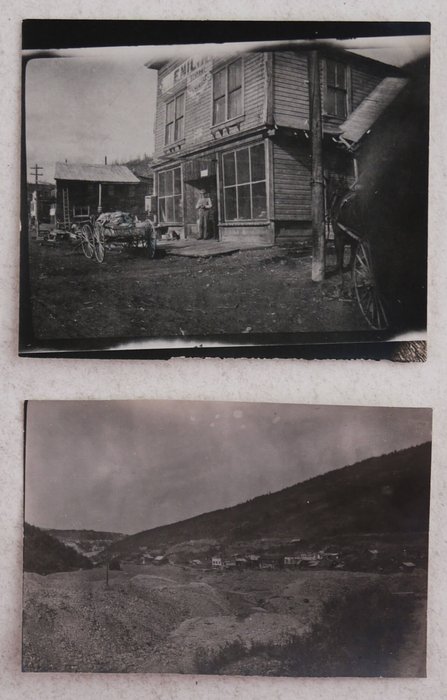
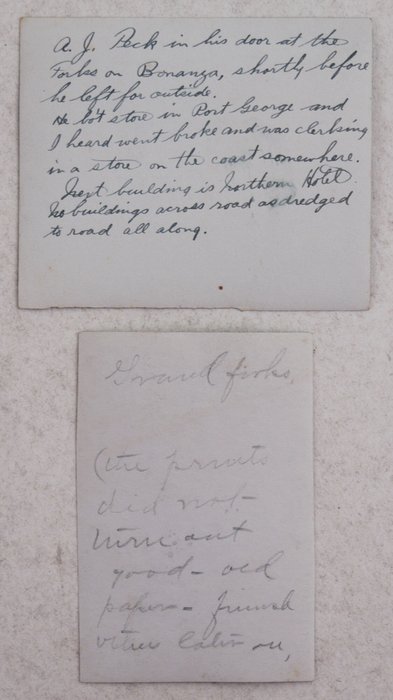
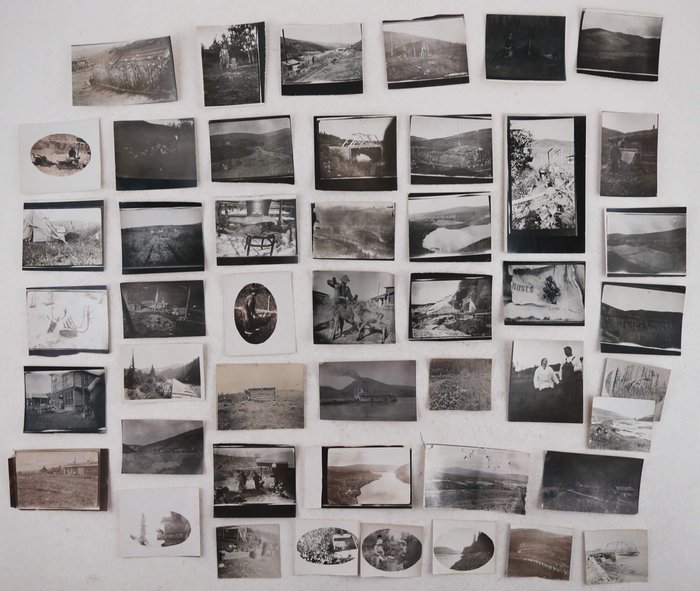
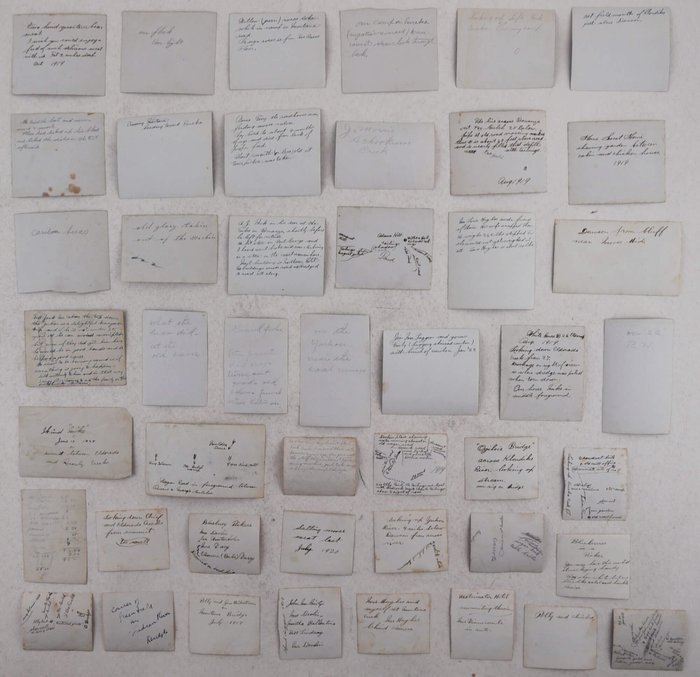
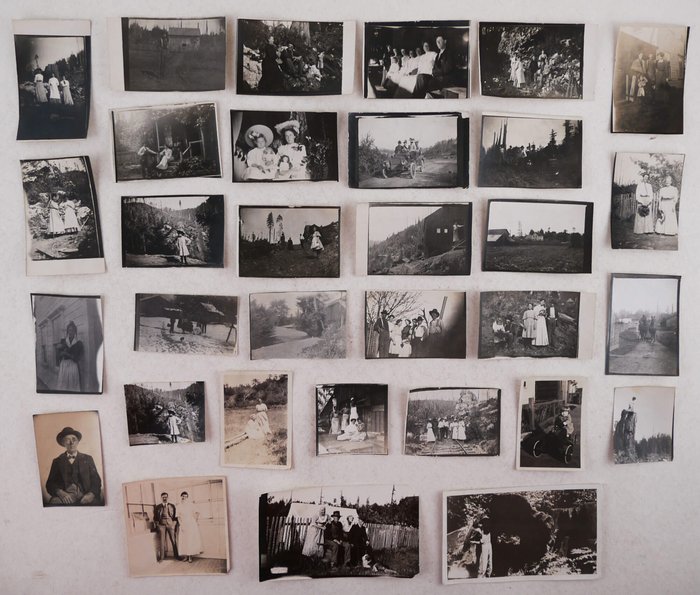
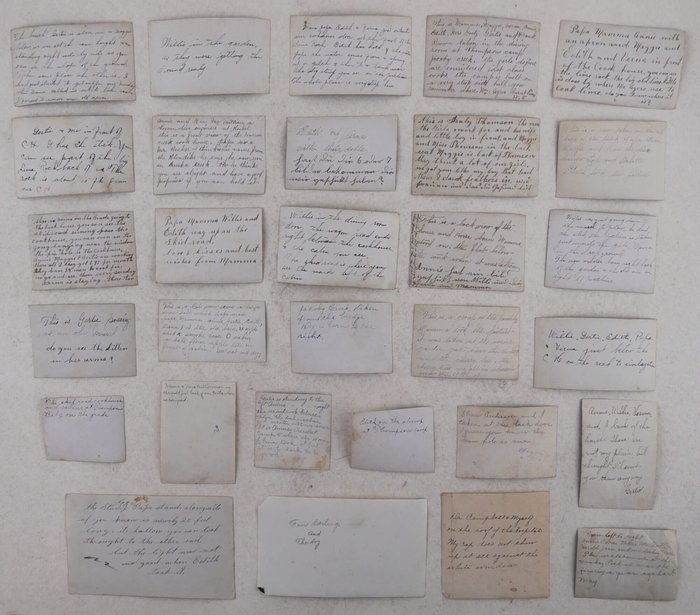
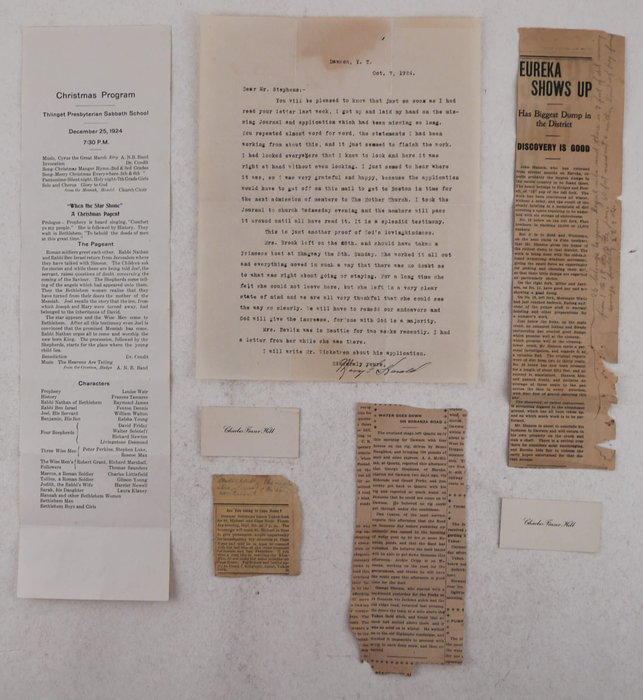
#PC40
Ca. 1900s – early 1920s
Over 220 original loose gelatin silver photos (including over forty duplicates, some of which contain additional manuscript notes), from ca. 8x14 cm (3x5 in) to ca. 5,5x6 cm (2 x 2 ½ in). Over 130 photos with period ink or pencil captions on verso (some also with dates on verso). With twenty-six amateur real photo postcards, including twenty-three larger ones, ca. 8,5x14 cm (3 ¼ x 5 ½ in) and three smaller ones, ca. 7x11 cm (2 ½ x 4 ¼ in); most are with addresses, postal stamps and period ink or pencil manuscript text on recto and/or verso. With two printed postcards, both ca. 9x14 cm (3 ½ x 5 ½ in). A few photos mildly faded, with occasional minor creases or losses of corners, but overall a very good collection of rare interesting photos.
With two printed business cards of Charles Fraser Hill, each ca. 3,5x7,5 cm (1 ¼ x 2 ¾ in); a typewritten letter to Stephens from “Mary F. [Harold?]” (Dawson, October 7, 1924), ca. 27,5x21,5 cm (10 ¾ x 8 ¼ in); a printed “Christmas Program. Thlinget Presbyterian Sabbath School,” ca. 44x11,5 cm (17 ¼ x 4 ½ in); and three period newspaper clippings regarding gold mining in the Klondike and Nome. With ca. 35 photos of Stephens’ family in California, from ca. 8,5x14 cm (3 ¼ x 5 ½ in) to ca. 5x7 cm (2 x 2 ½ in); most with period ink or pencil captions on verso.
Historically significant, extensive and well-annotated collection of original gelatin silver photographs and amateur real photo postcards (printed after the compiler’s negatives), taken by a Klondike gold miner, George Stephens, during his life and work on the Eureka and Montana Creeks, south-west of Dawson City, in the 1900s-1920s. According to the records obtained on Ancestry.com, Stephens was born in Chicago in a family of German immigrants to the United States, who eventually moved to Bayside, California. Stephens left home in 1899 and became a miner in the Yukon with occasional years spent back home. Stephens returned from Eureka Creek to Bayside, California “for permanent living” in January 1925 (U.S. Border Crossings from Canada to U.S., 1895-1960; 1910 U.S. Federal Census; 1921 Census of Canada; Ancestry.com).
Over a hundred photos from the collection show the premises and operations in the gold mining camp No. 11, located on Eureka Creek, a left tributary of the Indian River in the Klondike Goldfields. According to the captions, Stephens owned and operated the camp with his partner, a Klondike pioneer Charles Fraser Hill (ca. 1866 - 1924). The latter was “a native of England,” “a pioneer of the Yukon since 1898” and “a well-known mining man,” who “operated for years on Eureka Creek” (Yukon Pioneer Since ‘98// The Daily Province. Vancouver, B.C., 21 May 1924, p. 15). Stephens and Hill worked together on Eureka Creek throughout the 1910s, adding plantations of sugar beets to their operations in 1918, with the goal of production of sugar and syrup, which “may lead to one of the largest and most far-reaching industries of the Northland” (Dawson Makes Sugar from Yukon Beets// Juneau Empire. December 23, 1918, p. 3). The fate of Stephens and Hill’s sugar beet production is not known, but the partnership ended in 1924, when Hill died in St. Mary’s Hospital in Dawson. He was buried in the famous Yukon Order of Pioneers cemetery on 8th Avenue.
Most photos of the Eureka Creek camp date back to 1911-1915 and include general views of the premises and surrounding hills, scenes with the miners working in an underground shaft (with mining equipment and candles to light up the space), “raking pay dirt into sluice boxes,” “C.F. Hill tending the tail race” (“he was cross when I shot at him, he would not even smile when I told him to watch for dickey bird”); a series of views of the main dump (a pile of gold-bearing gravel, dug out in winter for summer sluicing), featuring the scaffolding log structure and adjacent boiler house (with “Jonas Smith making water with steam power”), the boiler, &c. There are also numerous portraits of Stephens, Hill and their fellow miners, with several names identified: “C.F. Hill on snowshoes,” “Martin Pekoe, Geo. J.F. Stephens and John Martin after a bear hunt, each holding black bear cub in hand but they don’t show,” “Geo. A. Philbrook, Chas F. Hill and Albert McDonald in garden on bank of Indian River at mouth of Eureka Creek,” “Ove Knudsen and our pony (Polly),” “Jonas Smith resting on sled while hauling outfit from cache on No. 12 to No. 11, Eureka Ck, spring of 1911,” “G.J.F.S. trying to look pleasant,” “A.G. Wikstrom”, “Edward Lund,” &c. A large group of photos shows the main camp cabin, taken in winter and summer from several angles (note various vegetable plants, including “sweet peas” growing on the cabin’s walls in summer); there is also an image of the vegetable garden at camp No. 11 growing table and sugar beets, turnips, carrots, and onions). There is also a photo of the interior of the camp kitchen and a lively scene of the 1914 Christmas party, featuring “Ed Lund, Al Kimber, Theo Wacht, Gus Wikstrom, Chas Hill, F.J.H.S. (on margin), Tom Worren, Harry Ray, J. McLaggon.” An impressive photo of a pan full of gold nuggets is captioned “158 ounces, clean up, taken in Hill & Stephen mining properties on Eureka Cr., Yukon, claim No. 11.”
The collection also contains photos of other Klondike gold miners and their camps (“Monty Velge prospecting on Right Fork, Eureka;” “A.G. Wikstrom at foot of shaft, No. 3 above Discovery, Eureka;” “Al Kimber’s dump of 2 years ago, 1912”), portraits and scenes with various Klondike residents (“Christ Olsen and camp, where I stayed while hunting last fall, head of Montana Creek;” “Mr. & Mrs. Devlin in front of their home on No. 36 below Bonanza creek,” “Joe Winterholer in our rig on way to Wounded Moose mineral spring,” “A.G. Wikstrom (mail carrier) at Eureka mailbox, just after he & I had finished building the post office, on Steel Fork road 4 miles from Eureka,” “spud diggers, 1919,” “Polly and Gud Wikstrom on Montana Bridge, July 1917,” “Mr. & Mrs. Louis Hughes, Steel Fork Creek,” “J. Morris, Skookum Creek,” &c.).
There are also numerous views of the Klondike Goldfields, many with detailed captions identifying camps, valleys, roads, hills, &c.: “Klondike Mines Railway at the water tank at mouth of Mosquito Gulch, 36 below Discovery on Bonanza;” “Dogget House and Tims cabin, all that is left of Magnet City, silt filled to near windows and all dredged out behind;” “from road top of Poverty Bar, Railroad trestle and Adams Hill,” “looking up Boulder Ck, July 1917,” “pipe line across Bonanza at Fox Gulch, Aug. 1919,” looking up Eureka Creek,” “looking down Chief and Eldorado Creeks from summit,” and others.
Several annotated photos show Dawson City (“Gregg office – left, Regina Hotel – center, Principal Hotel, formerly Melbourne Hotel – right…,” “Westminster Hotel, now writing wherein,” “Dawson from bluff near Moose Hide”). There is also an interesting photo of Grand Forks – a gold rush town established in ca. 1898 at the confluence of Bonanza and Eldorado Creeks, but torn down in 1921 when gold dredges started to work on its site. Another important image is a rare close-up photo of “A.J. Peck in his door at the [Grand] Forks on Bonanza, shortly before he left for outside…;” the sign “General Merchandise” is clearly visible.
Among the other images are several views of Stephens’ mining camp on Montana Creek and its environs, including “Montana Bridge, the one I built in summer of ’22,” photos of Klondike road houses (“Indian River roadhouse, just sold and closed up,” “Montana Road H.,” “B.[lack] H.[ill] Road H.,” &c.), “Ogilvie Bridge across Klondike River,” fishing and hunting scenes (“100 ptarmigans and grouse, part of winter supply of meat,” “yours truly fishing for grayling in small lake 2 miles above Eureka Creek on Indian Creek,” “good catch of grayling laid out to freeze,” “Chas Fraser Hill with his bear he caught raiding the cache, Eureka,” “salting moose meat”), and many others.
Several photos contain Stephens’ notes on the quality of his images, giving an insight into the hardships of field photography production in the Klondike: “this is a very poor print, darkened by being too closely packed in fixing bath,” “negative spoiled,” “it is rather overexposed in printing,” “too dark, hold to light,” “flash spoiled film,” “rust spots from gold pan,” &c.
The real photo postcards were addressed to Stephens’ siblings in California (“Miss G. Stephens,” “Maggie M. Stephens,” “Mrs. M.M. Mohn,” “Mr. W.F. Stephens,” “Miss Edith Stephens,” &c.) and were mostly produced from the same negatives as the original photos. Extensive manuscript notes provide additional information on the photo’s subjects or circumstances which they were made in. The images show “cabin No. 11, Eureka” (“taken direct from Kodak by placing card inside),” Indian River Bridge, Dawson City (“the block all round where the N.C.Co. stores are located”), “Kimber, Peterson and Brown on Eureka Creek, spring of 1912,” “an interior I took of the cabin of A.G. Wikstrom, my hunting and fishing companion of two seasons,” “William Radford, the discoverer of Quartz Creek in Yukon,” the interior of “Kimber’s cabin,” “railroad trestle across the road on Poverty Bar,” “Jonas Smith on a sled load of grub on Eureka Creek, Apr. 1911,” “Flash light on No. 15 below forks on Eurker, 75 feet from shaft,” a malamute dog, and others.
One real photo postcard and one photo show Eureka Road House (now in Kantishna, Denali National Park and Preserve, Alaska). The real photo postcard features George Stephens, posing next to a sled with the sign “We all drink Greenlands Beer, made by Arctic Brewing Co., Fairbanks, Alaska.” The pencil caption notes that the photo was “taken Feb. 14, 1909, by Billy Cooper, the overland musher from Valdez to Seattle by dog team.” Another real photo postcard, sent in June 1915, contains an interesting reflection about the American participation in WW1: “Hope the U.S. can avert entering the struggle in Europe but it looks now as if there may be a possibility we will go in. The U.S. is heavily peopled by Germans and who knows to what extent their spy system extends <…>”
The additional materials include two printed business cards of Charles Fraser Hill, a typewritten letter to Stephens from one “Mary F. [Harold?],” a member of one of Dawson churches (dated October 7, 1924), a printed “Christmas Program. Thlinget Presbyterian Sabbath School,” and three period newspaper clippings regarding gold mining in the Klondike and Nome
The collection also contains about thirty family photos, showing members of the Stephens family in Bayside, California – largely when they lived and worked at Stanley Thomson’s logging camp at Jacoby Creek in the 1910s. The photos portray Stephens’ parents William and Margaret, brothers William F. Stiglich Stephens (d. 1954, a dairyman in Bayside) and Charles, sisters Annie, Margaret, Gertrude, Edith, and Verna, as well as family friends.
Overall, an extensive and well-annotated collection of original amateur photos documenting the life and work of Klondike gold miners in the 1900s-early 1920s.

